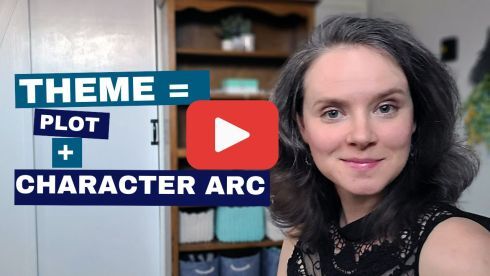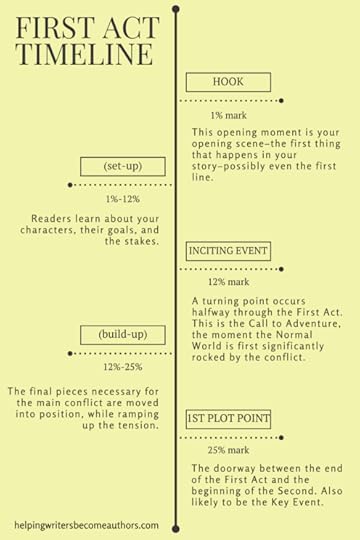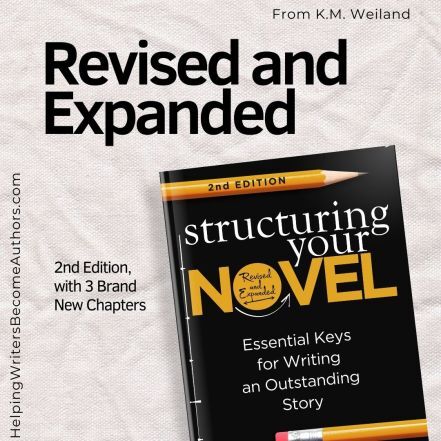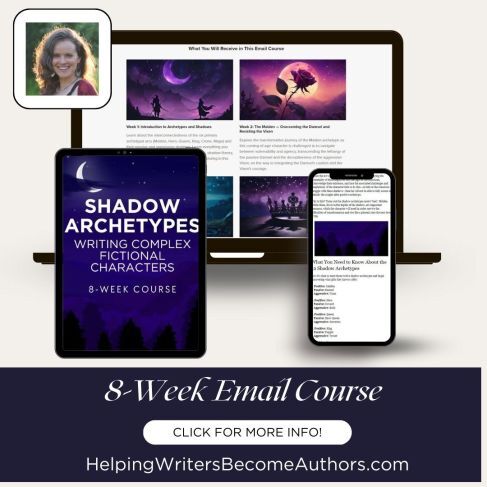K.M. Weiland's Blog, page 7
August 26, 2024
The First Half of the Second Act (Secrets of Story Structure, Pt. 6 of 12)
 Every segment of a story offers its own challenges, but perhaps none leaves more writers bewildered than the Second Act. At least beginnings and endings provide a checklist of things to accomplish. The middle of the story, on the other hand, is a yawning blank. You may feel like you’re entirely without a guide as you try to move your characters toward where they need to be for the ending to work. Fortunately, if you pay attention to solid story structure, you’ll find that the middle of the story has a checklist all its own. The Second Act is the largest part of your story, comprising roughly 50%. It begins after the First Plot Point at the 25% mark and continues until the Third Plot Point at the 75% mark.
Every segment of a story offers its own challenges, but perhaps none leaves more writers bewildered than the Second Act. At least beginnings and endings provide a checklist of things to accomplish. The middle of the story, on the other hand, is a yawning blank. You may feel like you’re entirely without a guide as you try to move your characters toward where they need to be for the ending to work. Fortunately, if you pay attention to solid story structure, you’ll find that the middle of the story has a checklist all its own. The Second Act is the largest part of your story, comprising roughly 50%. It begins after the First Plot Point at the 25% mark and continues until the Third Plot Point at the 75% mark.
Within the Second Act, we find three structural beats, once again falling at eighths within the overall structural timing:
The First Pinch Point – 37%The Midpoint (Second Plot Point) – 50%The Second Pinch Point – 62%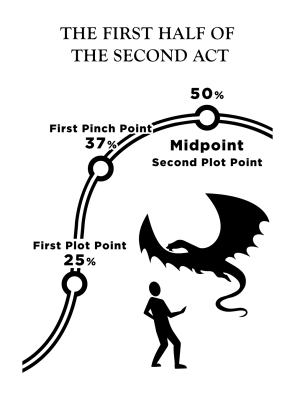
From the book Structuring Your Novel: Revised and Expanded 2nd Edition (Amazon affiliate link)
This week, we will discuss the First Half of the Second Act, which includes the First Pinch Point. Next week, we will devote an entire post to the Midpoint, and the following week we will cover the Second Half of the Second Act and the Second Pinch Point.

The First Half of the Second Act is the “reaction phase” of your story. This is where your characters find the time and space to react to the First Plot Point. Remember how we discussed the First Plot Point being definitive because it forced the characters into irreversible reaction? That reaction, which will lead to another reaction and another and another, creates your Second Act.
The First Plot Point hit your characters hard. Now, their lives are no longer running on the same smooth paths, and they have to do something about it. If you examine the First Plot Point in a story, you will see it is the characters’ reactions to the event that change everything and create the story. Even when the First Plot Point incorporates a life-altering tragedy (e.g., the murder of Benjamin Martin’s son and the burning of his plantation in The Patriot), the characters could conceivably continue their lives more or less as they had before. It’s their reaction (e.g., Martin’s becoming the “ghostly” militia leader who terrorizes the British army) that allows the chain of events to continue—and create a story.
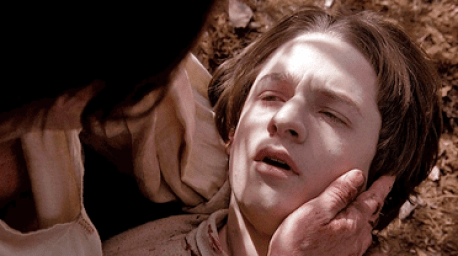
The Patriot (2000), by Columbia Pictures.
This is why introducing characters and other crucial elements in the First Act is so important. If you fail to properly set up the protagonist as someone who would logically react in the way necessary to facilitate the Second Act, your story will implode. When searching for the appropriate Characteristic Moment to introduce a character, consider an event that will reflect, inform, or contrast the character’s reaction to what happens later at the First Plot Point.
For the next quarter of the book, until the Midpoint, your characters will react to the events of the First Plot Point. They will take action, but all these actions are a response to what’s happened to them. They’re trying to regain their balance and figure out where their lives should go next.
For Example:
In my medieval novel Behold the Dawn, the characters spend this part of the book on the run from the bishop who wants them dead.In Brent Weeks’s The Way of Shadows, the protagonist spends years reacting to the orders of his master.In Lew Wallace’s Ben-Hur, the protagonist is forced into a reactionary role as a galley slave after he’s unjustly captured and sentenced at the First Plot Point.
Ben-Hur (1959), MGM.
Just because the characters are comparatively reactive in this phase does not mean they are passive. However, even though they are making choices and trying to move forward toward the plot goal, they are not yet able to be genuinely effective in doing so. Not until they reach a Moment of Truth at the Midpoint will they see themselves and the plot conflict in a clearer light. This will then allow them to switch into an “active phase,” in which their choices and actions become increasingly informed and calibrated in the Second Half of the Second Act. This is why the First Half of the Second Act is often where the character is learning the rules of the game—whether those are the nuances of a new relationship, the tricks of the trade in a new job, survival skills, or the social structure of a new neighborhood.
The First Pinch Point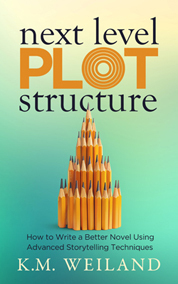 The First and Second Pinch Points are paired beats, both occurring in the Second Act, one prior to the Midpoint and one after. Although pinch points are just as structurally integral as plot points, they won’t always be represented by huge scenes. Their primary role is to provide a “pinch” that reminds the protagonist of the formidable obstacle represented by the antagonistic force and what is at stake should the protagonist fail.
The First and Second Pinch Points are paired beats, both occurring in the Second Act, one prior to the Midpoint and one after. Although pinch points are just as structurally integral as plot points, they won’t always be represented by huge scenes. Their primary role is to provide a “pinch” that reminds the protagonist of the formidable obstacle represented by the antagonistic force and what is at stake should the protagonist fail.
The First Pinch Point takes place halfway through the First Half of the Second Act at the 37% mark. Here, the antagonistic force can flex its muscles and impress with its capacity to disrupt the protagonist’s forward momentum. This moment serves primarily to set up the change of tactics the protagonist will soon learn. By reminding readers of the antagonist’s power, the First Pinch Point raises the stakes and foreshadows the central turning point at the Midpoint. Like all major structural beats, the First Pinch Point should focus on the central conflict rather than a subplot.
For Example:
The antagonist might jab at your protagonist’s weakness, as in Ever After, when the wicked stepmother exults to Danielle about the probability of her daughter marrying the prince.The protagonist might fail in his fight against the antagonist and be mocked or reprimanded for it, as in the film Warrior when Brendan’s brother Tommy rejects his attempts at reconciliation.If your story features your antagonist’s POV, your First Pinch Point might simply be a reminder of what the antagonist is planning, as in Captain America: The First Avenger when the Red Skull murders his superiors and goes rogue or as in The Empire Strikes Back when Emperor Palpatine tells Darth Vader that Luke Skywalker is their new enemy.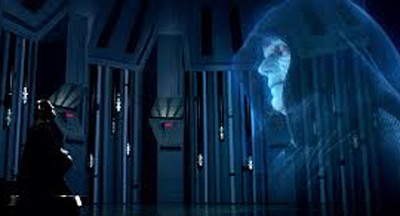
Star Wars: The Empire Strikes Back (1980), 20th Century Fox.
Character Realizations After the First Pinch PointAlthough the entirety of the First Half of the Second Act is a story’s “reaction phase,” the degree to which the characters shift out of reaction and into action will steadily evolve as they learn new skills. By the time they reach the Midpoint, they will encounter a definitive turning point that offers a concrete epiphany about themselves and the nature of the plot conflict. The events at the First Pinch Point will contribute to that process.
Whatever the characters learn at the First Pinch Point, even if it is just that the antagonist is more formidable than they thought, will fuel their continuing growth toward effectiveness in the plot. The section after the First Pinch Point and leading up to the Midpoint will solidify a state of realization for the protagonist. Think of these realizations as clues leading the characters to the major revelation at the Midpoint. A story’s most significant revelations—those that irrevocably change things for the protagonist and thus turn the plot—should be saved for the main structural turning points. However, most stories will require a chain of minor realizations that evolve the characters’ perspectives leading up to these seismic shifts.
For Example:
In Edith Wharton’s The Age of Innocence, the Midpoint declaration of love is preceded by the section in which the protagonist must internally grapple with and admit he is in love with a woman who is not his fiancée.In Little Women, the Midpoint revelation is Jo’s quiet Truth that life inevitably changes as everyone begins to grow up; this is preceded by a section in which many smaller changes occur, including her best friend Laurie going away to college.In The Martian, the Midpoint revelation is the stranded astronaut’s acknowledgment that he will probably die on Mars if he continues his current tactics. This is preceded by a section of small tragedies that successively limit his ability to survive.
The Martian (2015), 20th Century Fox.
Examples of the First Half of the Second Act From Film and LiteraturePride and Prejudice: After Bingley leaves Netherfield Park at Darcy’s prompting (the First Plot Point), Elizabeth and her sisters can do little except react. Jane goes to London to visit her aunt and to discover why Bingley left. In the absence of Mr. Wickham, Elizabeth pays an extended visit to her friend Charlotte (the new Mrs. Collins). While there, she again meets Mr. Darcy and is forced to react to his perplexing attentions.
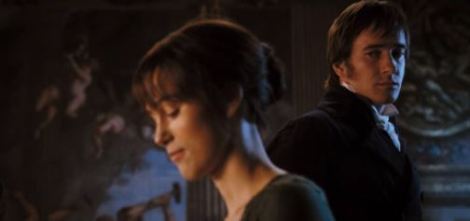
Pride & Prejudice (2005), Focus Features.
It’s a Wonderful Life: Even after the First Plot Point in which his father dies of a stroke, George’s life could have progressed exactly as he wanted it to. But when he reacts to Mr. Potter’s attempts to close down the Building & Loan by agreeing to stay in Bedford Falls and take his father’s place, his life is forever changed. For the next quarter of the movie, we find George adjusting to life in Bedford Falls. When his brother Harry (who was supposed to take George’s place in the Building & Loan) gets married and takes another job, George is again forced to react. He accepts he must stay in Bedford Falls, and he marries Mary Hatch—reactions that build upon his initial decision to preserve the Building & Loan.
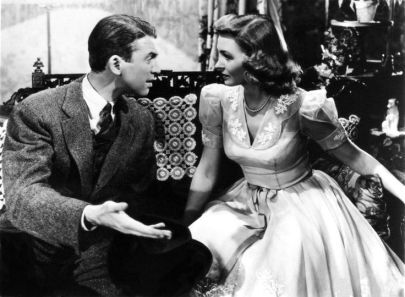
It’s a Wonderful Life (1947), Liberty Films.
Ender’s Game: After joining Bonzo’s Salamander Army, Ender struggles to stay afloat in Battle School. He learns to fight—and win—in the zero-grav war games. He makes friends and enemies and sets in motion the events that will later cause the standoff between him and the bully Bonzo. Everything he does in the First Half of the Second Act is a reaction to his presence in Battle School in general and his promotion to Salamander Army in particular.

Ender’s Game (2013), Lionsgate.
Master and Commander: The Far Side of the World: Captain Jack Aubrey and his crew spend the First Half of the Second Act reacting to their second sighting of the Acheron. After turning the tables on the enemy ship, Jack subsequently loses her during a tragic accident at Cape Horn and is forced to devise new plans and methods for managing his crew until they reach the Galapagos Islands.

Master and Commander: The Far Side of the World (2003), Miramax Films.
Top Things to Remember About the First Half of the Second ActThe characters should react promptly and irrevocably to the events of the First Plot Point.Because the characters’ lives and plans have been significantly altered, they must find new ways of dealing with the world in general and the main antagonistic force in particular.Their reactions should be deep and varied enough to create the next quarter of the story.Their reactions must be dominoes, moving the plot forward and deepening the weave of scenes, subplots, and themes.Often, this section is where the characters will gain the skills or items necessary for the final conflict in the Third Act.At the First Pinch Point, the protagonist will be pressured (either in person or even from afar and without knowing it) by the antagonistic force.The First Half of the Second Act deepens character development and foreshadows meaningful elements. Even in fast-paced action stories, this will often be the most thoughtful portion of your story as you finish building the foundation your characters will stand upon during the Climax.
Stay tuned: Next week, we will talk about the Midpoint, or Second Plot Point.
Wordplayers, tell me your opinions! Do ever you struggle with the Second Act in your stories? Tell me in the comments!Related Posts:
Part 1: 5 Reasons Story Structure Is Important
Click the “Play” button to Listen to Audio Version (or subscribe to the Helping Writers Become Authors podcast in Apple Podcast, Amazon Music, or Spotify).
___
Love Helping Writers Become Authors? You can now become a patron. (Huge thanks to those of you who are already part of my Patreon family!)The post The First Half of the Second Act (Secrets of Story Structure, Pt. 6 of 12) appeared first on Helping Writers Become Authors.
August 19, 2024
The Secret to Writing Strong Themes
 Today, I want to talk about writing strong themes, because there’s a lot of misunderstanding around the concept of theme (which is why I wrote the book Writing Your Story’s Theme). When we think of theme, we often think of a one-word or short phrase aphorism. For example, maybe the theme of the story is “love” or maybe it’s “overcoming a sense of unworthiness” or something like that. While that is very possibly what the story is about and what the theme is pointing to, that isn’t necessarily a good roadmap for helping you learn how to write strong themes. It’s valuable to look a little deeper and to understand how theme actually operates within a story, what its function is, and therefore how you can use the other elements of your story to consciously create the theme you want to create.
Today, I want to talk about writing strong themes, because there’s a lot of misunderstanding around the concept of theme (which is why I wrote the book Writing Your Story’s Theme). When we think of theme, we often think of a one-word or short phrase aphorism. For example, maybe the theme of the story is “love” or maybe it’s “overcoming a sense of unworthiness” or something like that. While that is very possibly what the story is about and what the theme is pointing to, that isn’t necessarily a good roadmap for helping you learn how to write strong themes. It’s valuable to look a little deeper and to understand how theme actually operates within a story, what its function is, and therefore how you can use the other elements of your story to consciously create the theme you want to create.

Writing Your Story’s Theme (Amazon affiliate link)
In the past, a common statement that has floated around the writing community is that “writers should never consciously write the theme.” There is some truth to this (which I’ll talk about in just a second), but ultimately, I adamantly disagree with this idea.
What this is really pointing to is the truth that writers never want to preach at their readers. You don’t want to try to start with some message you’re trying to share about the world and then shoehorn that into your characters’ mouths or their perspectives of the world and try to prove it through whatever is happening in the story. You don’t want to come into a story to prove, for example, some political statement. Readers don’t want that. It doesn’t work within the story because it isn’t organic or it doesn’t flow. It feels, even if the author isn’t actually preaching at you, that they’re trying to jam some specific moral message into a story that doesn’t fit.
However, I think this unfortunate effect most often happens simply because the writer has an idea of theme but doesn’t understand how it actually works within storyform. If you do understand how theme operates, you’re much less likely to end up with fragmented themes, in which your story is saying one thing while you’re trying to say something else with the theme. Likewise, you can also avoid the problem of getting to the end and realizing what you thought was your story’s theme doesn’t seem to have anything to do with what’s actually happening.
In either case, you can end up having either stories that seem very disjointed, or even two different endings that are trying to individually address the plot and the theme. This creates a story that doesn’t feel cohesive and resonant.
However, if you understand what you’re doing and how story creates them, then you can accomplish two things.
1. You can consciously create anything you want to create within the realm of your story.
2. Perhaps most importantly, you can double-check and troubleshoot what isn’t working. If you get to the end of the story and you feel your theme is off the rails or nonexistent, you can go back and check what happened by asking, “Where do I need to work with the story in order to make the theme more powerful and pertinent?”
What Is Theme, Really?The most important thing to understand about theme is that it doesn’t exist in a vacuum. It’s not its own thing within the story. It’s part of the greater whole. Specifically, it forms what I call “the trifecta” of plot, character, and theme. These three elements of story create each other; they do not exist by themselves in isolation. One necessarily creates the other.
We sometimes hear the idea of plot versus character, as if they were two totally separate things, when really they can’t be. The plot has to create the character, the character has to create the plot. Theme is the third part of that.
Here’s the thing: if you have a functional story that’s working, what that means is that all three of those things—plot, character, and theme—are working. Even if you’re not conscious of theme—even if you didn’t do it on purpose, so to speak—if all three are in cohesion with one another, that’s what you want. If you can bring consciousness to your administration of theme, then you can do it on purpose.
Here’s how it works. Let’s say you come up with an idea for a plot. Necessarily, there must be characters in that plot. Although it may take a little time, as you flesh out that plot in your mind, you will begin to understand what kind of people are driving this plot. What kind of people are interested in going to the places and achieving the things that you want to see happen in this plot?
This works in reverse as well. If you start with an idea for a character, obviously you don’t have anything for them to do until there’s a plot. So pretty soon you start getting ideas for what these characters will do. What are they interested in? How are they interacting with other people? What do they want? What are they moving toward? Suddenly, you have a plot. Plot and character are not separate. One necessarily creates and brings with it the other.
The same is true of theme.
How Plot and Character Arc Create Theme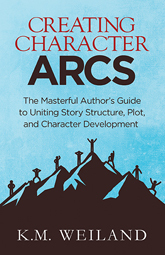
Creating Character Arcs (Amazon affiliate link)
The interaction between plot and character is the engine that creates theme. We talked about in the last video about the Lie the Character Believes and how that creates this entire arc of the character’s evolution as they change their perspective, as they evolve into a new way of being and a new identity within the world. That’s character arc. And this new understanding of the world is something that has to be acted upon. It’s not just something happening in the character’s head. Otherwise, there’s no reason for the change to happen within the plot. It will be just an expression of philosophy, not a story. You have to bring this change of perspective into the action of the plot. Show what the character is going through, dramatize it through the events of the plot.
The events of the plot and the arrival of the conflict prompts the need for this change within the character. And then the change inside the character also allows them to evolve and grow what they’re doing in the external plot. If they remained the same, then either they wouldn’t be motivated to go on this story’s adventure at all or, depending on the type of story, the events of the plot will destroy them. They’ve got to evolve in order to survive. They’ve got to evolve in order to reach this next level of whatever it is the story wants them to achieve, whether that’s a relationship or a new job or saving the world or whatever the case may be. Some quiet literary stories really are just about changing that inner landscape. Whatever the case, this change must be proven in some way. It must be acted out within the plot.
Using Your Plot as a Thematic MetaphorI like to think of the plot as a metaphor for whatever the character is changing internally, for the story’s Lie and Truth. Let’s say you start with the character’s Lie and Truth. And from there, you ask yourself what can the character do physically in the world that would dramatize and show this inner transformation from Lie to Truth.
An easy example of this would be The Hunger Games, in which the protagonist Katniss Everdeen follows a Flat Arc. This means she doesn’t change her perspective; she doesn’t grow from Lie to Truth. Instead, she uses her understanding of the Truth to change the world around her. In this case, that Truth would be her understanding that “oppression is no good,” that this Lie that has been fed to her country Panem by its oppressive government is that “their control is necessary to protect them” and the brutality of the Hunger Games is also necessary. Katniss begins her story understanding this is not true, as many people in her world do. What makes her an interesting character and protagonist is that her story gives her the opportunity to act on that Truth.
Specifically in this story, we can see how the entire premise of the Hunger Games—the entire scope of the plot in this story—is a very specific dramatization of her story’s Lie and Truth that allows her to go out and actively battle this oppression. She’s basically put in a cage and has to fight her way out. That’s a very explicit example of how your plot can operate as a thematic metaphor.
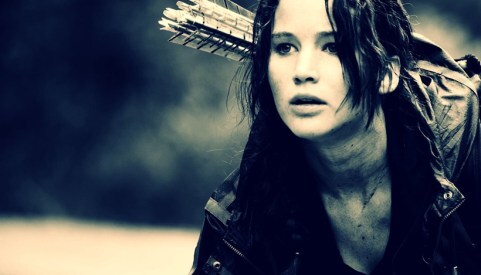
The Hunger Games (2012), Lionsgate.
When you’ve got plot and character working together beautifully, we might say one is proving the other. From this, we get a theme. Even if you try to paste on a different kind of a theme, the events of your story and how your character responds to them and interacts with them is what inevitably creates the theme. That is the point of your story; that is the message of your story. The thematic Truth that will be proved by the end of your story is whatever is shown by the events of the story. Whatever is effective in your story is your story’s Truth. This can be something very practical such as a skill, but it can also be just an effective perspective that the characters hold of themselves or the world (e.g., self-worth).
Using Plot and Characters to Identify Your Story’s ThemeWhen you approach a story from the idea that plot, theme, and character are all equal members of the equation and that necessarily one creates the other, it allows you to make sure you’re creating a cohesive cycle. And also, when you’re running into problems, it allows you to stop and check.
Let’s say you’re having problems with your theme. “I don’t know what my theme is.”
Look at your character’s arc and specifically at the Lie the Character Believes. Look at what they need to overcome by the time they get to the end of the story and therefore what Truth they’re moving toward. That Truth is usually a very specific and easy way to sum up your story’s theme.
You can also look at the events of the plot.
What are the characters doing?What is happening?What is challenging them?Where do they fail?What do they have to do to succeed?How do they have to change in order to become someone who can succeed in gaining the plot goal within your story?This is where you can start looking for a theme and vice versa.
Using Theme to Create Your Plot and Character ArcsLet’s say you start out knowing you want to write a story about “love conquers all”—that’s your theme, that’s what you want to write about. There’s no reason you can’t start with just that. Now you have a map for determining what kind of characters and what kind of character arc will help exemplify this.
How will they be challenged to grow into this?What Lie might oppose this idea?What events of the plot will be an interesting way to explore all aspects of this idea?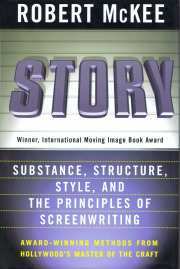
Story by Robert McKee (affiliate link)
Deepen Your Themes With the Thematic SquareThis is where it can be really helpful to bring in a technique that Robert McKee wrote about in his book Story, which he called the Thematic Square. Start by examining your story’s thematic Truth from multiple perspectives. This prevents it from being just this simple black-and-white approach, i.e., “this is the wrong way to do it, and this is the right way to do it.” That approach is simplistic and can be on the nose and ultimately unconvincing to readers because that’s not really how it works for most of us most of the time in real life. If it was that simple, we’d always think, Ah, truth. I want to do that. I pick that one because obviously it’s better. It’s obviously going to be more effective and help me get what I want, what I need, and what’s good for me.
But it’s not that simple, right?
There are many shades and complexities to this evolution of perspective because the Lie and the Truth are actually never black and white. Rather, they represent an evolution along the spectrum, from a limited perspective to a broader perspective. Ideally, you want to be able to explore the complexities around this idea.
The Four Corners of the Thematic SquareYou can do this, via McKee’s Thematic Square, by creating a square with four corners that represent four different sides or points of the thematic premise you’re exploring.
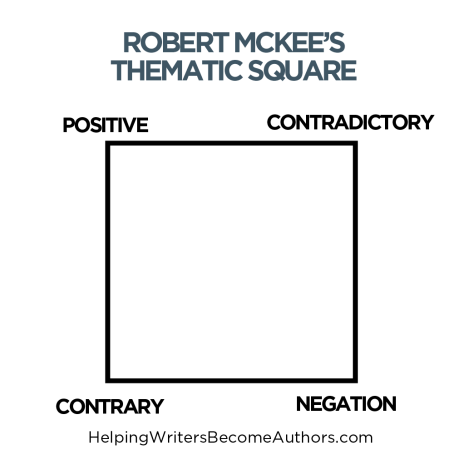
First and foremost, you have the Positive corner. Positive represents the story’s Truth. This is the good stuff you’re trying to posit in your story, i.e, “this is the way we should be”—whether the character embraces it and succeeds or fails to embrace it and fails within the story. This is the positive Truth you are suggesting is the best way for the characters to behave in this story. Examples of this would be Respect or Love. These are good qualities. These are things that we recognize as something we want to to embody in our lives, because they will help us to be more effective in whatever we’re doing.
The Contradictory Thematic StatementOpposite that is the Contradictory corner. This represents something that is directly contradictory to the story’s positive Truth. At its simplest, this is the Lie. This is what stands opposed to the story’s Truth. In simple one-word explanations of what these might be, we have in opposition to Respect, Disrespect. In opposition to Love, we have Hate.
The Contrary Thematic StatementThose two are obvious; they’re an obvious polarity. From there, you can start moving down to the bottom corners of your square and think about, first of all, what would be an element within this thematic exploration that would be Contrary to the Positive.
The word contrary always makes me think of somebody who’s being contrary: they’re just being annoying. They’re just being stubborn and refusing to see things. It’s not necessarily that they represent or are directly opposed to the argument, but they’re just refusing to do it. They’re opting out, saying, “talk to the hand,” as we used to say. The Contrary perspective wants to bypass the whole thematic argument. In some ways, this makes it more dangerous than the contradictory aspect, which at least is looking at the Truth—looking it in the eye and doing battle with it. In contrast, the Contrary aspect just wants to skip it. It doesn’t even want to engage with this Truth.
An example of this for a theme of Respect, could be Rudeness. Rudeness is passive-aggressive. “I don’t respect you, but I’m not actually doing you the service of coming to your face and telling you that either.” For Love, the Contrary aspect could be Indifference, which in many ways can be more painful than Hate in some relationships. We often say love is hate flipped on its head, with the idea being that if you can dig down there in the hate, you might be able to find love in the shadow and integrate it. Indifference, however, says, “I don’t care about you. You don’t exist to me. You’re dead to me. I don’t think about you at all.” And this can be more painful and certainly more difficult to move through toward that more positive Truth.
The Negated Thematic StatementFinally, we have what McKee calls the Negation of the Negation. This is the Lie taken to its farthest extreme. It’s taken to such an extreme that it’s as if the Truth doesn’t exist. It rewrites reality. Over the course of the story, a Negation character will be given an opportunity to see the Truth and how it could potentially positively impact their life. But for whatever reason, they reject it and end up in a worse place than when they just believed the Lie or the Contradictory aspect.
In our example of Respect, the Negation of the Negation would be Self-Disrespect. Usually, even if someone disrespects someone else, there’s that place within their own ego where they are still standing within their own sense of identity and pride of self in opposition to something else. However, with Self-Disrespect, they can’t even respect themselves. If there isn’t even that ego container to hold their own identity, that is, in many ways, a worse place to be than if you’re just this egoic person disrespecting everybody else. It’s an almost plague-like effect. The seed of the Lie takes over the person’s entire being and life and perhaps beyond depending on the type of story you’re telling. The example McKee uses as the Negation of Love is Self-Hatred. Again, the Negation sees the character moving into a place where love doesn’t even exist in their universe.
How to Implement the Thematic Square in Your Story
Creating Character Arcs (Amazon affiliate link)
One of the best ways to explore the Thematic Square is to have your protagonist represent any one of the thematic corners with the antagonistic force representing the polar opposite. Depending on whether you’re telling a Positive Change Arc, a Flat Arc, or a Negative Change Arc, your protagonist may or may not represent the Positive statement.
You can also use the Thematic Square to deepen this thematic complexity by looking for ways in which multiple characters—at least four characters—represent the different aspects of the square. This gives the protagonist a chance to interact with all of them, to be challenged by all of them, and to see the pros and the cons of each one so that they’re challenged. Their exploration of the theme will no longer be a simple binary choice between, “Oh, the Lie is bad and the Truth is better, so of course I’ll choose the Truth.” Rather, they have to move through all of these shadow aspects of the Lie and the Truth, to explore them, and to be challenged by them.
If your project uses characters to represent all four aspects, this also helps you develop and deepen the opportunities for your plot. Make sure every character’s actions, everything that’s happening, any opposition the protagonist faces from antagonistic forces is all thematically pertinent.
No thematic position in your story should be random. If the protagonist is trying to move toward a thematic Truth of “Love,” you don’t want another over here focusing on Freedom and Slavery. That’s a totally different theme. Of course, there can always be crossover—because ultimately everything is interconnected in real life. But applying the Thematic Square to your story can help you recognize which ideas don’t support the point of your story. If something doesn’t support the plot’s throughline and doesn’t support the protagonist’s individual arc, ask yourself how you could repurpose it so it informs the central theme.
Find Your Theme by Examining Your Story’s EndingWhen thinking about how best to integrate theme into plot and character arc, look at how your story ends. The ending of your story—your Climactic Moment—will prove what your story was really about. This means it will prove what your theme is really about.
The decisions your characters make in the end, the perspectives they use to inform their choices and actions, as well as their ability to gain their plot goal—all of these things reveal your story’s theme. Examine the questions your story raises and the answers it ultimately ends up giving.
This does not mean that you need to end with some kind of moral of the story or with the mentor character coming out and giving a little speech about the lesson to be learned or something like that. Your story’s “answer” is simply whether or not the characters were effective and how they end up.
Did they end in a better place physically, spiritually, emotionally, and mentally?Or is it a worse place?If it’s a better place, then the story’s Truth (i.e., the “answer” to the questions that have been raised throughout the story), is “yes, this is an effective way of being in the world. This is a good course of action.”
If the characters fail, either ambiguously or definitively, then what the story is saying is “this is not a good way of being.” Such a story becomes, even without any need to create a moral of the story, a cautionary tale.
Find Your Theme by Examining Change and Consequence in Your PlotFinally, think about how your story will develop change and consequence.
Change, both within your story’s character arcs and within the context of how your characters are able to enact change in the outer world of the story will prove what the story is really about. It will show you how your theme develops, what thematic questions are at play, and what answers the plot ultimately posits.
Specifically, think about consequences. Consequences aren’t always something negative. From a causal perspective, consequences can be something good. However, more often, consequences reveal a hard pill to swallow. Not only can consequences sometimes prove that “oops, the characters did not choose the best way of being. They did not choose the story’s Truth,” but consequences can also offer a resonant way to drive home that this path of change, this path of evolution that we’re all on within our lives, isn’t easy. It’s not cut and dried. It’s not black and white.
Again, if theme was simply “Lie versus truth—this is worse and this is better,” we’d always choose the right thing. There would be no need for stories because we’d always choose the right thing. Stories show us that there are, in fact, consequences even for choosing the right thing, for choosing what’s best for us, for choosing something we believe is in the best interest of ourselves and our communities and our world. Stories show us life isn’t simple, that there are always sacrifices, that letting go of a Lie or dealing with people who aren’t ready for us to let go of the Lie—it’s not easy. Embracing the Truth is often difficult.
Examining the consequences your characters face or could face if you deepen your story can be helpful in showing you not just your story’s theme, but how to deepen it and then explore all of the depth of it. Go into the shadows and explore the profundity of change. Ultimately, that’s what theme in story is about.
Admittedly, theme is an abstract concept. Zooming in and thinking of it in terms of plot and character makes it more concrete and easy to master within your story. Again, I’ve written a whole book about theme. So if you want more, you can check out Writing Your Story’s Theme.
Happy writing!
Wordplayers, tell me your opinions! What do you think is the most challenging part of writing strong themes in your stories? Tell me in the comments!Click the “Play” button to Listen to Audio Version (or subscribe to the Helping Writers Become Authors podcast in Apple Podcast, Amazon Music, or Spotify).
___
Love Helping Writers Become Authors? You can now become a patron. (Huge thanks to those of you who are already part of my Patreon family!)The post The Secret to Writing Strong Themes appeared first on Helping Writers Become Authors.
August 12, 2024
The First Plot Point (Secrets of Story Structure, Pt. 5 of 12)
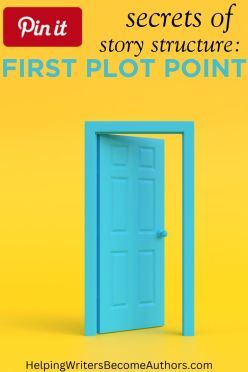 The First Plot Point is a linchpin in narrative architecture. This pivotal moment thrusts the protagonist into a new and irrevocable direction. Positioned around the 25% mark, it serves as a seismic shift, propelling the tale from the initial groundwork of the First Act into the uncharted territory of escalating tension and conflict.
The First Plot Point is a linchpin in narrative architecture. This pivotal moment thrusts the protagonist into a new and irrevocable direction. Positioned around the 25% mark, it serves as a seismic shift, propelling the tale from the initial groundwork of the First Act into the uncharted territory of escalating tension and conflict.
This juncture marks the end of the story’s setup and catapults characters and readers alike into the heart of the narrative arc. By introducing a significant development (often a challenge or revelation) that forces the protagonist to confront the core conflict head-on, the First Plot Point drives the story forward with a cascade of consequences. As a catalyst that shapes the plot’s trajectory and sets the stage for the ensuing drama, it is one of the most critical cornerstones in storytelling.
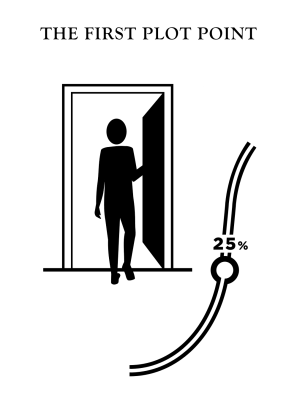
From the book Structuring Your Novel: Revised and Expanded 2nd Edition (Amazon affiliate link)
What Is the First Plot Point?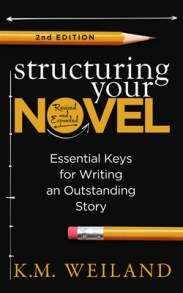 The First Plot Point signals the transition from the setup of the First Act into the full-on immersion of the Second Act. Up to now, the story has focused primarily on setting the stage and laying the groundwork for what will follow. From here, the story will use this foundation to create the back-and-forth drama of the characters pursuing their goals and confronting obstacles.
The First Plot Point signals the transition from the setup of the First Act into the full-on immersion of the Second Act. Up to now, the story has focused primarily on setting the stage and laying the groundwork for what will follow. From here, the story will use this foundation to create the back-and-forth drama of the characters pursuing their goals and confronting obstacles.
The First Plot Point kicks off the main conflict by ensuring that two potent ingredients fuse to create the alchemy of plot. The first of these ingredients is your protagonist’s plot goal. Although the main plot goal may have been explicit throughout the First Act, it is more likely to have originated in this early section of the story as a vague or unformed desire. This could also be expressed to readers by dramatizing circumstances that need to change for your characters.
As the protagonist progresses through the First Act, and especially the Inciting Event, this desire or need will emerge more and more explicitly. By the time the First Plot Point arrives, the motivation will coalesce into a concrete intention that urges the character forward. This intention will continue to evolve over the course of the story as the character arc refines the character’s inner perspectives. What happens at the First Plot Point should create a cohesive throughline of intent to generate this forward momentum.
For Example:
In Ever After, the protagonist’s throughline goal is always saving her family’s farm, even as her desires in her relationship with Prince Henry evolve over the course of the story. Her intentions about the farm motivate and influence her every action in the relationship.
Ever After (1998), 20th Century Fox.
In order to create the plot conflict in the Second Act, the second necessary ingredient that must come into play at the First Plot Point is antagonistic opposition. When we speak about the necessity of “conflict” in a story, what we are really speaking about is the necessity of the character’s forward progress toward the goal being impeded by obstacles. When we speak of the “antagonist” or the “antagonistic force,” what we are really speaking of is whoever or whatever consistently creates those obstacles.
 The true significance of the First Plot Point is that it is the moment at which the protagonist’s goal and the antagonist’s opposition join inextricably. In some stories, the antagonistic force and its obstacles may be present in full force right from the beginning of the story, in which case it is the protagonist’s full commitment to the goal that initiates the conflict at the First Plot Point. In other stories, the protagonist may be fully intent on the goal much earlier but does not fully confront opposition to that goal until the First Plot Point. In still other stories, neither the protagonist’s goal nor the antagonistic force’s opposition become fully realized until this moment.
The true significance of the First Plot Point is that it is the moment at which the protagonist’s goal and the antagonist’s opposition join inextricably. In some stories, the antagonistic force and its obstacles may be present in full force right from the beginning of the story, in which case it is the protagonist’s full commitment to the goal that initiates the conflict at the First Plot Point. In other stories, the protagonist may be fully intent on the goal much earlier but does not fully confront opposition to that goal until the First Plot Point. In still other stories, neither the protagonist’s goal nor the antagonistic force’s opposition become fully realized until this moment.
Regardless, the First Plot Point signals a shift out of the Normal World of the First Act. It moves your characters into the symbolic Adventure World of the Second Act, in which they will discover what is at stake if they remain committed to their goal. It is important to note, however, that even should the characters at some point regret their decision to pursue this goal in the face of opposition, they cannot go back to the way things were. The First Plot Point is symbolically a Door of No Return.
By committing to the plot goal and discovering opposition from the antagonist, the protagonist’s choice here changes things. Even in low-stakes stories, the characters’ choice at the First Plot Point will permanently change either themselves or the world around them. Often, this will be dramatized by a change in setting. The character will literally switch “worlds” by moving to a new and more challenging setting. In other stories, in which the main setting remains the same, this can be signified by introducing new elements into the existing setting.
For Example:
In Legally Blonde, the ditzy protagonist is accepted into Harvard Law School. Up to this point, her attempts to get her boyfriend back didn’t create permanent change in her life. By deciding to follow him to law school, the actions she takes forever alter the trajectory of her life—no matter what happens next.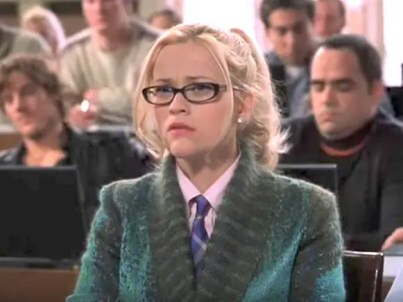
Legally Blonde (2001), MGM.
Where Does the First Plot Point Belong?The First Plot Point occurs around the 25% mark, signaling the end of the First Act. As always, this timing represents an ideal and will be subject to the unique pacing needs of each story. What is most important in timing your First Plot Point is ensuring the preceding First Act has enough space to fully develop and lay the groundwork for the story to come without belaboring events.
Why place the First Plot Point at the 25% mark? Why here and not at the 10% or 40% mark? If you’ve ever watched or read a poorly plotted story that skipped or postponed the First Plot Point, you probably instinctively perceived the story was dragging. Without the turning point of the First Plot Point, the First Act will drag on too long—or, conversely, if the First Plot Point takes place too early, the Second Act will drag.
If you pay attention while watching a movie, you can time the major plot points down to the minute. This makes film an especially valuable medium for studying structure since you can view the entire story structure in one sitting and precisely identify structural beats by dividing the total running time into eighths. You can, of course, also do this with books. Divide the total page count by eight and note what happens near each section. Just remember that the timing in a book will not likely be as precise as in a shorter medium like film.
>>Click here to read structural breakdowns in the Story Structure Database.
You won’t always know exactly where the timing of a specific plot beat falls within your overall story until you have finished it, although you can create rough projections by evaluating how many scenes will take place in each section. However, once you have completed your story and can evaluate the timing of every structural beat within the whole, you can use the timing of the First Plot Point to evaluate whether the first half of the Second Act is proportionally too long or too short.
People often wonder if the First Plot Point is part of the First Act or the Second Act. My view is that the First Plot Point can more properly be seen as a transitional zone between the two. Continuing with the doorway metaphor, we can think of the First Plot Point as a portal between the Normal World and the Adventure World.
Although considered a single beat, the First Plot Point can comprise many scenes forming a cohesive sequence. Particularly if the events of your First Plot Point are shattering and/or you are dramatizing a large-scale action scene, you may require more than a few scenes to realistically create the event you’re trying to convey. I generally time structural beats at the moment the character changes within the larger scene or sequence. In the First Plot Point, this is when the protagonist’s goal becomes inextricably entangled with the antagonist’s opposition. This is the moment from which the protagonist cannot return, the moment when there is no going back.
The Difference Between Plot Points and BeatsYou may sometimes hear the term “plot point” used to reference any moment of change or impact within a story. However, I prefer to use “plot point” to refer exclusively to structural moments of change within the story. Although your story will feature only a specific few structural turning points, it can have any number of beats, some relatively minor, some shockingly huge. Beats are what keep your story moving forward. They mix things up, keep the conflict fresh, and propel your character far away from any possibility of stagnancy.
For Example:
The movie Changeling features several cataclysmic beats in the First Act (including the kidnapping of the heroine’s son at the Inciting Event, the return of the wrong boy, and the police department’s insistence that she accept the child anyway) before her decision, at the First Plot Point, to fight back against the corrupt police department.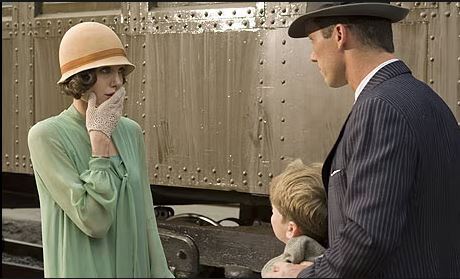
Changeling (2008), Universal Pictures.
What differentiates a structural plot point from every other story beat is the fact that everything changes for the character. One reason I capitalize terms when referring to significant structural moments in the plot structure is to emphasize that these beats are particularly important. The First Plot Point marks a place of no return for your characters. It is the beat when the setup ends and your protagonist crosses a personal Rubicon.
Examples of the First Plot Point From Film and LiteraturePride and Prejudice: After the ball at Netherfield Park, Darcy and the Bingley sisters convince Mr. Bingley to return to London and forget his growing affection for Jane. Much has already happened in the story. Jane and Elizabeth have stayed over at Netherfield. Lydia and Kitty have become enamored of the militia. Wickham has turned Elizabeth against Darcy. And Mr. Collins has proposed to Elizabeth. Then everything changes at the 25% mark when Darcy and the Bingleys leave. This is the event that breaks Jane’s heart and infuriates Elizabeth against Darcy. It also changes the story’s landscape, since several prominent characters are no longer in the neighborhood for the Bennets to interact with as they did throughout the book’s first quarter.

Pride & Prejudice (2005), Focus Features.
It’s a Wonderful Life: Throughout the first quarter of the story, George Bailey’s plans for his life have progressed uninterrupted. Despite his misadventures in Bedford Falls, he’s headed for a European vacation and a college education. Then the First Plot Point hits. When his father dies of a stroke, George’s plans are dashed. This moment forever changes George’s life, setting the subsequent plot points in motion. As in Pride & Prejudice, the standards that have been established in the story are dramatically altered. This is no longer a story about a carefree young man freewheeling around town. From here, this is a story about a man forced to assume responsibility by taking over his father’s beloved business.

It’s a Wonderful Life (1947), Liberty Films.
Ender’s Game: The quarter mark finds Ender graduating to Salamander Army after a victorious confrontation with the bully Bernard. Ender’s assertion of brains, tenacity, and leadership allow him to claim his spot at Battle School. He makes it clear to himself, the other children, and the watching instructors that he will do whatever he must to survive. This First Plot Point also changes the game (no pun intended) by once again moving Ender to new surroundings. As a member of Salamander Army, he is dropped into a new place, new quarters, and a new set of challenges.

Ender’s Game (2013), Lionsgate.
Master and Commander: The Far Side of the World: After refitting the Surprise and heading back to sea to look for the French privateer Acheron, Captain Jack Aubrey is confident everything will go according to his plans. He is thrown for a loop by the First Plot Point. Instead of the Surprise finding the Acheron, the captain wakes to discover the enemy bearing down on his much smaller ship. Not only is his victory at risk but now he and his crew are in danger of being captured. They scramble to escape, and the game of cat-and-mouse that will comprise the rest of the film begins in earnest.
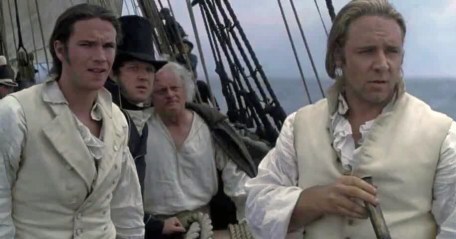
Master and Commander: The Far Side of the World (2003), Miramax Films.
Top Things to Remember About the First Plot PointThe First Plot Point occurs around the 25% mark.The First Plot Point is an event that changes everything and becomes a personal turning point for the main character.The First Plot Point almost always changes the story so irrevocably that even the character’s surroundings (either the physical setting or the cast of supporting characters) are altered.The First Plot Point is something to which the main character must be able to react strongly and irretrievably.The First Plot Point is one of the most exciting moments in any story. Choose a robust and cataclysmic event to which your characters must adamantly react. Hit readers so hard at the end of the First Act they won’t even think about closing the book.
Stay tuned: In two weeks, we’ll talk about the First Half of the Second Act.
Wordplayers, tell me your opinions! What happens at your story’s First Plot Point? Tell me in the comments!Related Posts:
Part 1: 5 Reasons Story Structure Is Important
Click the “Play” button to Listen to Audio Version (or subscribe to the Helping Writers Become Authors podcast in Apple Podcast, Amazon Music, or Spotify).
___
Love Helping Writers Become Authors? You can now become a patron. (Huge thanks to those of you who are already part of my Patreon family!)The post The First Plot Point (Secrets of Story Structure, Pt. 5 of 12) appeared first on Helping Writers Become Authors.
August 5, 2024
The Inciting Event (Secrets of Story Structure, Pt. 4 of 12)
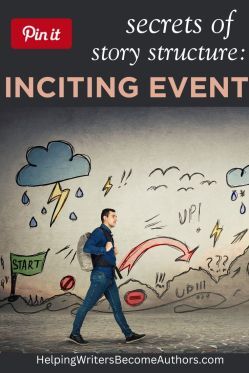 The Inciting Event is one of the most crucial turning points in story structure. It can either make or break your narrative. Many writers, however, struggle with its intricacies and timing. Is the Inciting Event the initial brush with the main conflict? Is it a Call to Adventure met with refusal? Where does it belong in the structure of your story, particularly within the context of the First Act? By analyzing examples from film and literature, we can unravel these complexities and learn to create an impactful Inciting Event.
The Inciting Event is one of the most crucial turning points in story structure. It can either make or break your narrative. Many writers, however, struggle with its intricacies and timing. Is the Inciting Event the initial brush with the main conflict? Is it a Call to Adventure met with refusal? Where does it belong in the structure of your story, particularly within the context of the First Act? By analyzing examples from film and literature, we can unravel these complexities and learn to create an impactful Inciting Event.
As the first major turning point in your story, the Inciting Event marks a transition from the setup in the first half of the First Act into the buildup in the second half, as the story begins to ramp into the characters’ full-on immersion in the conflict in the Second Act. As its name suggests, this is the event that “incites” or initiates the plot’s main conflict. Also sometimes referred to as the Inciting Incident, this all-important beat signals that this is what the story is all about.
Misconceptions About the Inciting Event (and the Key Event)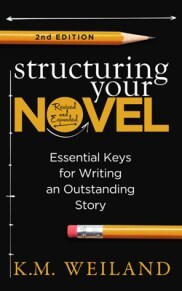 For all that the Inciting Event is crucial to creating a functional plot, it is often misunderstood. My own understanding of the Inciting Event has evolved drastically over the years, and some of my own foggy ideas (as published in the first edition of Structuring Your Novel) have contributed to the confusion. I amended some of this when I offered my free e-book 5 Secrets of Story Structure as a supplement, but one of the main reasons I wanted to create an updated second edition of Structuring Your Novel, as well as updating this series, was to share a more accurate and useful approach to the Inciting Event.
For all that the Inciting Event is crucial to creating a functional plot, it is often misunderstood. My own understanding of the Inciting Event has evolved drastically over the years, and some of my own foggy ideas (as published in the first edition of Structuring Your Novel) have contributed to the confusion. I amended some of this when I offered my free e-book 5 Secrets of Story Structure as a supplement, but one of the main reasons I wanted to create an updated second edition of Structuring Your Novel, as well as updating this series, was to share a more accurate and useful approach to the Inciting Event.
The main thing that has changed about how I view the Inciting Event is that I no longer see its timing as vague. I originally taught that the Inciting Event could take place just about anywhere in or before the First Act. In that view, the Inciting Event might be an event in the character’s backstory that motivates the main plot. Or it might be the plot domino found in the first chapter. Or it might take place halfway through the First Act. Or it might coincide with the Door of No Return—the First Plot Point at the 25% mark.
This wobbly structural timing was based on a conflation of several different important motivating events within the plot’s timeline. When each of these events is given its own name, it becomes clear where the true Inciting Event really lands and what it actually is. Before we go deeper, let’s take a moment to properly identify each of these beats within the story.

Creating Character Arcs (Amazon affiliate link)
Motivating event in the protagonist’s backstory: This is the Ghost (also sometimes called the wound), a term originated by John Truby, which I discuss in my book Creating Character Arcs. As something that happens before the story, it is not properly a part of the plot structure. Rather, it creates context for why characters believe a limiting Lie about themselves or their reality. This Lie will then be challenged by the events of the main plot and will create the characters’ inner journey via their character arcs.
First plot domino in first chapter: As we discussed in Part 2, this initiation of the story’s cause and effect is created by the Hook at the very beginning. This beat functions to set up the story world and the characterizations that will lead to the true Inciting Event a few chapters later.Turning point halfway through the First Act: Here we find the true home of the Inciting Event, which we will explore in the rest of the post.The Door of No Return at the end of the First Act: This beat is the First Plot Point. It is one of the three most prominent turning points in the entire story (along with the Second Plot Point or Midpoint at the 50% mark and the Third Plot Point at the 75% mark). In order for this beat to create a dramatic and irrevocable turn of events leading into the Second Act, it must be built upon a previous event that incites those events. We will explore the First Plot Point in next week’s post.
From the book Structuring Your Novel: Revised and Expanded 2nd Edition (Amazon affiliate link)
As we parse out the function and timing of these catalysts within the story, a clearer picture emerges of how the First Act operates. This picture also supports the pattern of timing and pacing that creates an important turning point every eighth of the story.
Some of you may notice I have not mentioned the Key Event in this lineup. In the first edition of Structuring Your Novel, I wrote:
The Key Event is the moment when the character becomes engaged by the Inciting Event…. The Key Event is the glue that sticks the character to the impetus of the Inciting Event.
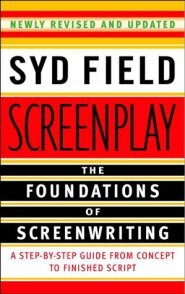
Screenplay by Syd Field (affiliate link)
This was based on Syd Field’s teaching in Screenplay about the two beats:
[T]he inciting incident… sets the story in motion … [while] the key incident [is] what the story is about, and draws the main character into the story line.
At the time, I also believed in a flexible timeline for the Key Event, associating it more with the Inciting Event than any other beat. I now associate the Key Event with the First Plot Point. On the whole, I find it more straightforward to focus on the fixed beats of the Inciting Event and the First Plot Point.
I apologize for any confusion my own treatment of these terms has caused in the past. I hope this new information will clear up any perplexity.
What Is the Inciting Event?Now that we’ve explored what the Inciting Event isn’t, what exactly is it?
The Inciting Event is the turning point halfway through the First Act. Up to now, the First Act has mostly concerned itself with setup—with setting the stage, introducing the characters and their motivations, and indicating what is at stake for them. None of these introductions or the scenes they inhabit have been random. Each has been a domino knocking into the next, creating that flawless chain of cause and effect. However, up to this point, these scenes will not have particularly focused on what will become the main conflict in this story.
Although the protagonist will have a desire in the first half of the First Act, or at least a reason to desire something, this desire won’t yet have solidified into a solid plot goal.
For Example:
In The Hunger Games, Katniss starts out disliking the antagonistic Capitol and resisting them in small ways that ensure her family’s survival. She has yet to form the specific plot goal that will directly engage her with that antagonist. Therefore, the story’s main conflict has not yet begun. Rather, these early scenes lay the groundwork for that conflict.
The Hunger Games (2012), Lionsgate.
The Inciting Event is where the main conflict significantly intrudes upon the character’s life. I like to say the Inciting Event is where the protagonist “brushes” the main conflict. This contrasts the full-on immersion in that conflict, which the character will experience at the First Plot Point. The difference is one of degree. Even if the happenings at the Inciting Event are quite radical (e.g., Katniss volunteering as tribute to protect her little sister), they will not be as radical as what happens later at the First Plot Point (e.g., starting to train as a tribute).
The characters’ full engagement with the main conflict cannot happen until they form the main plot goal. That will happen at the First Plot Point and will signal the shift out of the First Act into the Second Act. The Inciting Event exists to set up the First Plot Point. Because the plot goal will not yet be fully formed, the character’s response to the Inciting Event will be uncalibrated and perhaps even uncertain. This “brush” with the antagonistic force knocks them off balance.
In the Hero’s Journey terminology, the Inciting Event carries the energy of what is known as the Call to Adventure. When we examine the archetypal underpinnings of story structure, we see that this is the moment when the characters are invited to step beyond a familiar comfort zone. They are challenged to push their growth edges, to step into a “wider world,” and to test their mettle.
Aptly, the forward momentum of the Call to Adventure will almost always be met with a Refusal of the Call, as the characters resist what their changing circumstances are now asking of them. In some stories, the protagonist will explicitly try to refuse the Call to Adventure by avoiding the consequences of the Inciting Event. In other stories (such as Hunger Games), the refusal may occur primarily within the protagonist, as represented by feelings of fear or inadequacy. In still other stories, the refusal may be represented by counsel or resistance offered by supporting characters who do not want the protagonist to engage with the main conflict by enacting a specific plot goal.
Where Does the Inciting Event Belong? The Inciting Event splits the First Act, taking place around the 12% mark in the story. This timing does not need to be exact. The shorter your story, the tighter your timing should be; the longer your story, the more wiggle room you will have. However, the significance of the Inciting Event’s timing is that it must allow enough space before to realistically set up whatever will happen at the Inciting Event, including what will motivate the characters to respond as they do. Most of the important elements need to be in place (or at least foreshadowed) by the time you reach the Inciting Event.
The Inciting Event splits the First Act, taking place around the 12% mark in the story. This timing does not need to be exact. The shorter your story, the tighter your timing should be; the longer your story, the more wiggle room you will have. However, the significance of the Inciting Event’s timing is that it must allow enough space before to realistically set up whatever will happen at the Inciting Event, including what will motivate the characters to respond as they do. Most of the important elements need to be in place (or at least foreshadowed) by the time you reach the Inciting Event.
The timing of your Inciting Event must also allow for the second half of the First Act to focus on scenes that develop your characters’ reactions to the Inciting Event. From here, the rest of the First Act will shift out of setting things up into building up to the First Plot Point. Structurally, the First Plot Point is a massive moment in your story and will almost always be represented by a suitably dramatic event. The second half of the First Act builds into that moment. Most importantly, this section of the story is where your characters will begin forming a concrete plot goal.
In stories in which the characters are more reactionary (i.e., are at the mercy of a much larger antagonistic force), their plot goal may not become concrete until the First Plot Point. In these stories, the focus in the second half of the First Act may be on increasing tension and raising the stakes so the characters have little choice but to engage by the time they reach the First Plot Point.
For Example:
In Star Wars: A New Hope, Luke Skywalker’s Inciting Event introduces him to the opportunity of leaving Tatooine with Ben Kenobi—a Call to Adventure which he refuses—but when his aunt and uncle are murdered at the First Plot Point, he has no choice but to accompany Ben.
Star Wars: A New Hope (1977), 20th Century Fox.
Other stories will feature a more proactive protagonist whose desire for the goal creates the conflict, rather than the conflict creating the goal.
For Example:
In Bend It Like Beckham, protagonist Jess joins the soccer team not because anything forces her, but because it is her dream. This puts her in conflict with her family, but she initiated the events. In stories like this, the protagonist often spends the scenes between the Inciting Event and the First Plot Point taking deliberate steps toward a full commitment to the plot goal.
Bend It Like Beckham (2002), Fox Searchlight Pictures.
In stories that feature particularly life-changing Inciting Events, such as The Hunger Games, the Inciting Event will still build up to the First Plot Point. Occasionally, in such stories, the First Plot Point will be less dramatic than the Inciting Event, but will still structurally function to fully engage the protagonist with the main plot goal.
For Example:
Even though Katniss’s dramatic Inciting Event forever changes her life, she does not fully engage with the main plot conflict of surviving the Hunger Games until she reaches the Capitol, where she begins training as a tribute.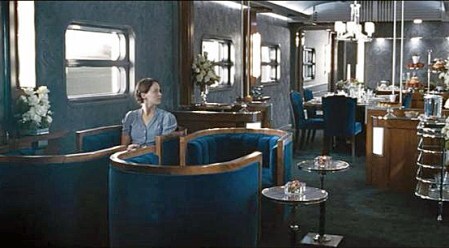
The Hunger Games (2012), Lionsgate.
In most stories, the three major plot points (First Plot Point, Midpoint, Third Plot Point) will feature the story’s “biggest” scenes. It is important to remember that even in stories in which this is not true, the structural timing and the specific roles of each structural beat remain the same.
Examples of the Inciting Event From Film and LiteraturePride and Prejudice: Although Elizabeth and Darcy spar at the Meryton assembly dance, forming opinions of each other they will spend the rest of the story trying to overcome, the true Inciting Event is the scene in which Elizabeth becomes the Bingleys’ guest while her sister Jane is staying there as an invalid. This sequence “brushes” Elizabeth against the main plot conflict by initiating her relationship with Darcy. From here, their paths will become more and more intertwined.
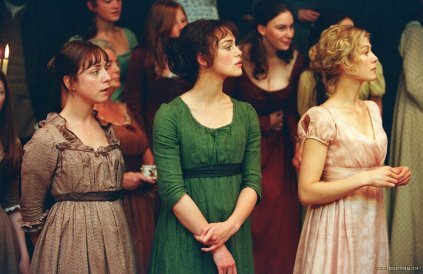
Pride & Prejudice (2005), Focus Features.
It’s a Wonderful Life: This classic movie uses the entirety of its First Act to leisurely introduce and build its characters. Its gentle Inciting Event occurs on the night of the high school dance when George’s father asks him if he would be willing to stay in Bedford Falls to help run the Bailey Brothers Building & Loan. George promptly refuses his father’s request. This sets up the central throughline and George’s central conflict between his need to stay and help contrasted with his burning desire to leave Bedford Falls.

It’s a Wonderful Life (1947), Liberty Films.
Ender’s Game: The First Act frames the central conflict by introducing a world that has been under attack by the Formic aliens for over eighty years. The protagonist, young Ender, is not directly impacted by this larger conflict until the Inciting Event when Col. Graff and the International Fleet Selective Service recruit him. He is taken to Battle School, where he will be trained to outwit and outfight the aliens.
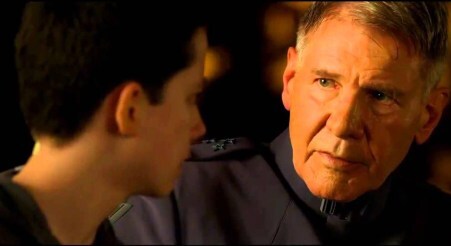
Ender’s Game (2013), Lionsgate.
Master and Commander: The Far Side of the World: This film’s structure is interesting in that the Inciting Event sequence takes up almost the entirety of the first eighth of the movie. This sequence of scenes features the sneak attack by the enemy ship Acheron upon the protagonist’s ship, HMS Surprise. After this attack, around the 12% mark, the protagonist must repair the ship and decide how to respond.
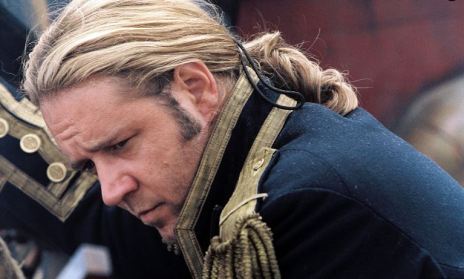
Master and Commander: The Far Side of the World (2003), Miramax Films.
Top Things to Remember About the Inciting EventThe Inciting Event takes place halfway through the First Act, around the 12% mark.The Inciting Event is the moment when the protagonist “brushes” into the main conflict, antagonist, or goal in a way that requires a response.The Inciting Event lays the foundation for the protagonist’s subsequent full-on engagement with the main conflict.The Inciting Event is a Call to Adventure, challenging the character to either rise up in resistance against something or move proactively toward a desire.This Call to Adventure is initially refused, perhaps internally or perhaps by a proxy character, as the protagonist faces the weight of what is at stake in engaging with the conflict.The Inciting Event signals the end of the First Act’s “set up” and the beginning of the “build up” toward the Second Act.A solid Inciting Event creates the foundation for your entire story. Don’t settle for anything less than the most powerful and memorable scene you can come up with. Time it strategically within the First Act and use it to engage your readers just as irretrievably as it does your main character.
Stay tuned: Next week, we’ll talk about the First Plot Point.
Wordplayers, tell me your opinions! Can you identify the Inciting Event in your work-in-progress? Tell me in the comments!Related Posts:
Part 1: 5 Reasons Story Structure Is Important
Click the “Play” button to Listen to Audio Version (or subscribe to the Helping Writers Become Authors podcast in Apple Podcast, Amazon Music, or Spotify).
___
Love Helping Writers Become Authors? You can now become a patron. (Huge thanks to those of you who are already part of my Patreon family!)The post The Inciting Event (Secrets of Story Structure, Pt. 4 of 12) appeared first on Helping Writers Become Authors.
July 29, 2024
The First Act (Secrets of Story Structure, Pt. 3 of 12)
 The First Act is the first major section within story structure. It comprises the first quarter of the story and focuses primarily on setting up and introducing the plot. As the foundation for everything, a solid First Act ensures your plot can achieve solidity and depth in subsequent acts.
The First Act is the first major section within story structure. It comprises the first quarter of the story and focuses primarily on setting up and introducing the plot. As the foundation for everything, a solid First Act ensures your plot can achieve solidity and depth in subsequent acts.
Within the First Act, we find three important structural beats:
The Hook – 1%The Inciting Event – 12%The First Plot Point – 25%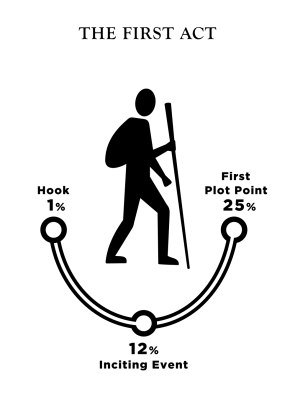
From the book Structuring Your Novel: Revised and Expanded 2nd Edition (Amazon affiliate link)
The Hook, which we discussed in last week’s post, begins the story by introducing the first domino in the row of causality that will allow each scene to lead into the next. At that point, the protagonist will likely not yet be engaged in the main conflict. What happens at the Hook begins to set up the conflict, providing the first bit of foreshadowing and context.
 The Inciting Event, which we will discuss next week, divides the First Act in half, providing the story’s first important turning point. It symbolically represents the Call to Adventure and invites the protagonist to engage with the primary conflict.
The Inciting Event, which we will discuss next week, divides the First Act in half, providing the story’s first important turning point. It symbolically represents the Call to Adventure and invites the protagonist to engage with the primary conflict.
The First Plot Point does not discretely belong in either the First Act or the Second Act. Instead, it creates the “threshold” or Doorway of No Return between the Normal World of the First Act and the Adventure World of the Second Act. The First Plot Point is when your protagonist becomes fully engaged with the primary conflict. From here, the protagonist will not be able to turn back from the pursuit of the goal without consequences. We will discuss this all-important beat in more depth in a few weeks.
From this brief overview, you can see that the primary focus of the First Act is not the immersion of the protagonist in the story’s main conflict. Rather, the First Act is where the story develops the reasons the character will choose to engage with the antagonistic force later on. The story will go full-on in the Second Act. For that intensity to make sense, the First Act needs to provide context for what follows. You can think of the First Act as foreshadowing for the Second and Third Acts. It is the plant to the subsequent payoffs.
Setting Up the Story: Characters, Settings, and Stakes After hooking readers, your main task in the First Act is to put your early chapters to work introducing your characters, settings, and stakes. Twenty-five percent of your book might seem a tremendous chunk of the story to devote to introductions. But if you expect readers to stick with you throughout the story, you must give them a reason to care. Mere curiosity can only carry readers so far. Once you’ve hooked their sense of curiosity, you must then deepen the pull by creating an emotional connection between them and your characters.
After hooking readers, your main task in the First Act is to put your early chapters to work introducing your characters, settings, and stakes. Twenty-five percent of your book might seem a tremendous chunk of the story to devote to introductions. But if you expect readers to stick with you throughout the story, you must give them a reason to care. Mere curiosity can only carry readers so far. Once you’ve hooked their sense of curiosity, you must then deepen the pull by creating an emotional connection between them and your characters.
These “introductions” include far more than the moment of introducing the characters and settings or explaining the stakes. In themselves, the presentations of all the important characters probably won’t take more than a few scenes. After the actual introductions is when your task of deepening the characters and establishing the stakes really begins.
In one sense, the First Act is like a program for a play. Its primary purpose is to prepare readers for what’s in store. You’re using these early chapters to indicate which characters are important, what type of story readers can expect, and where the journey will take them.
The first quarter of the book is where you compile the necessary components for your story. Anton Chekhov’s famous advice that “if in the first act you have hung a pistol on the wall, then in the following one it should be fired” is just as pertinent in reverse: if a character fires a gun later in the book, that gun should be foreshadowed in the First Act. The story you create in the following acts can only be assembled from the parts you’ve shown or foreshadowed in the First Act.
Introducing Your Story’s CharactersYour first duty in the First Act is to allow readers the opportunity to learn about your characters. Who are these people? What is the essence of their personalities? What core beliefs will be challenged or strengthened throughout the book? If you introduced someone in a Characteristic Moment, as discussed last week, then you were already able to show readers who this person is. From there, the plot can build as you deepen the stakes and set up the conflict that will explode halfway through the First Act in the Inciting Event and later at the First Plot Point.
Every story spreads out the arrival of important cast members differently. Usually, prominent actors should all be on stage by the time the bell rings at the end of the First Act. You can find exceptions in which prominent characters don’t arrive until late in the story (e.g., Cynthia in Wives and Daughters), but these late arrivals must be well planned. An arbitrary new character is never a good idea.

Wives & Daughters (1999), BBC/WGBH Boston.
Try to introduce all the following players within the First Act:
ProtagonistIntroduce the protagonist as quickly as you can, in the first scene if possible (and it should almost always be possible). The early introduction of the main character signals to readers this is the person whose story they’re reading and therefore this is the person to whom they need to attach loyalty.
AntagonistYou’ll usually introduce or at least foreshadow the antagonist early on, both to get the conflict rolling and to foreshadow the opposition to whatever your character cares about.
Love InterestParticularly if your story is a romance, but even if the love story is only a subplot, you will most likely bring your protagonist’s love interest on stage in the First Act. Although you don’t have to signal these two people will end up in love, you can at least signify the character’s importance with an early introduction.
SidekickMinor characters come and go in a story. Some will be important, some won’t. Those who will be at your protagonist’s side for the majority of the book deserve at least a short intro sometime before the First Plot Point.
Mentor
Writing Archetypal Character Arcs (affiliate link)
Mentor characters (which may or may not be Mentor archetypes) can enter a story just about anywhere in the first two acts, depending on their importance and the size of their roles. When possible, avoid convenient plot twists later on by introducing, or at least foreshadowing, a mentor character’s existence in the First Act.
Introducing Your Story’s StakesAs your characters walk onto the stage, they will bring the stakes along with them. What they care about—and the antagonistic forces that threaten what they care about—must be shown or hinted at to foreshadow the deepening conflict of the Second Act.

Creating Character Arcs (Amazon affiliate link)
Keep in mind the arc you’re trying to create for your characters. Some characters may need to endure a nuclear holocaust to learn their lessons and change their ways. Other times, the catalyst a story needs (i.e., the “worst” thing that can happen) will be smaller and more intimate.
Whatever that worst thing ends up being, you must set it up in the First Act. If your character’s daughter is going to be kidnapped, the First Act is the place to show readers how much her daughter means to her. You can’t up the stakes later on without something first being at stake.
It’s not enough to merely mention whatever is at stake for your characters. You must also take the time to develop it. Don’t be in such a hurry to get to the action that you neglect this foundation in the First Act. You can explain the stakes outright (“I love my little girl,” the mother says. “I would do anything to make a better life for her.”), or you can prove them through action (the mother lovingly swings her daughter at the playground)—or both.
The more proof you supply of your character’s investment in something (i.e., family, job, honor, etc.), the higher the stakes will be when that thing is threatened. The First Act is your first and most important opportunity to supply this proof. Once the First Plot Point hits at the 25% mark, the story will move too quickly to fully establish these important aspects of your character.
Introducing Your Story’s SettingsWhy is it important to introduce prominent settings in the First Act? Aside from the necessity of grounding readers in the story world, well-planned settings will empower your story with continuity and resonance. Your setting is the visual frame that unifies your story. If your book takes place in a prison, that’s the box in which readers will put your story when they think about it. Shawshank Redemption and The Great Escape? What do you think of when you hear those titles? The prison setting is what defines them and frames their plots.
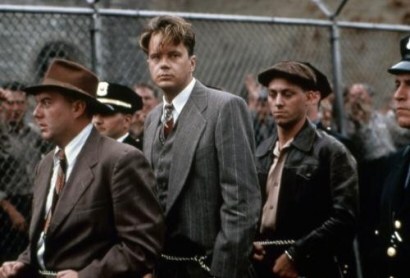
Shawshank Redemption (1994), Columbia Pictures.
But what if you write your prison story so the character doesn’t land in jail until the First Plot Point at the 25% mark? What if the settings in the First Act won’t ever be seen again? Maybe your protagonist starts out as a loving father who is wrongly accused of murder and tossed into the pen. You spend the first quarter of your story establishing his Normal World with his suburbanite family, then bam! he’s in jail and he won’t return to the suburbs for the rest of the book.
Even if you introduce a new batch of settings later on, your early settings are crucial for establishing character and stakes. Early settings can also create contrast when your poor protagonist is dumped in the brig later. Setting is the foundation of verisimilitude. Make readers believe they’re in a real place, and you’ve won half your battle against their skepticism.
Setting should never be an arbitrary choice. Consider what settings the plot will require, then try to create a strong reading experience by eliminating extraneous settings. A limited number of settings gives both you and the readers less to keep track of and allows more opportunities for deepening existing settings. A handful of important settings will allow you to create thematic resonance when you return to them at key moments in the story, thus bringing their presence in the story full circle.
Let’s say your jailbird dad in the previous example is released from prison during the story’s Climax. If you stage your closing scene back home in the suburbs, you’ll bring the story full circle, neatly closing the frame you opened in the First Act. By the same token, if he doesn’t get to go home at the end of the story, you might want to question whether opening with the suburban setting was your best choice.
What if the protagonist is on a journey with no main setting? Journey stories present a different set of challenges. What you’ll need to create in this sort of story is a “transient setting.” Alert readers that the characters will be jumping from setting to setting, then ground readers with the details that will remain the same no matter where the characters are. If they’re with a camel caravan in Egypt or just driving cross-country in their Jeep 4×4, these, in essence, become the primary settings no matter where the characters go.
The hectic nature of journey stories, particularly adventure stories, creates a milieu in which their exoticness is the setting. When you open the story with an exotic setting and plant the expectation that the character won’t be staying long, you’re providing the same foreshadowing as you would by using a more domestic story’s First Act to accustom readers to one or two prominent settings.
Examples of the First Act From Film and LiteraturePride and Prejudice: Ten pages in, we’ve met all the major characters, learned about the setting, and seen what’s at stake for the Bennet daughters if one of them can’t ensnare the unwitting Mr. Bingley. By the time we reach the First Plot Point, we’ve gotten to know all the sisters. The beauty and sweetness that will eventually win Jane a husband, the independence and strong opinions with which Elizabeth drives the conflict, and the foreboding irresponsibility of the youngest daughter Lydia are all in place and ready to be developed later in the story. We’ve also been introduced to the Bingleys, Darcy, and Wickham. Before the First Act is over, Bingley is in love with Jane, and Elizabeth has made up her mind to dislike Darcy—the two factors that will drive the story to come.
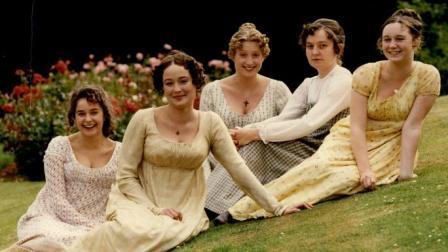
Pride & Prejudice (2005), Focus Features.
It’s a Wonderful Life: Under the guise of explaining George Bailey to novice angel Clarence, the senior angels show us the prominent moments in George’s young life. We see him as a child, saving his little brother from drowning, going deaf in one ear, and preventing old Mr. Gower from accidentally poisoning a customer. We glimpse him as a young man, planning his escape from “crummy” Bedford Falls, even as he becomes smitten with the lovely Mary Hatch. By the time the Inciting Event strikes, we know George Bailey inside out. We’ve been introduced to Bedford Falls and its colorful array of denizens. And we’ve learned of the stakes from George’s father, who explains the importance of the Bailey Brothers Building & Loan in giving the people a financial haven from evil Old Man Potter.

It’s a Wonderful Life (1947), Liberty Films.
Ender’s Game: Card uses his First Act to establish his setting: the orbital Battle School, where brilliant young children train to stave off an alien invasion. We learn about this strange and brutal place through the eyes of the main character, Ender Wiggin, who is a new arrival. This also allows us to learn about Ender. We see his determination and his kindness, but also the underlying bedrock of his ruthlessness—around which the entire plot turns. Almost all the significant supporting characters are introduced. Readers are shown what is at stake, not only for the human race, but also for Ender if he does not overcome the handicap of his extreme youth in order to flourish in this place.
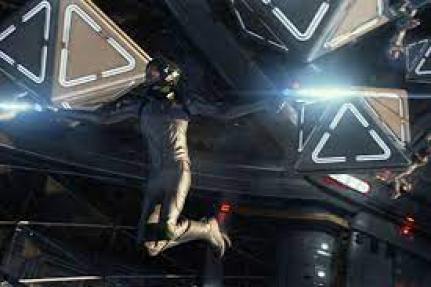
Ender’s Game (2013), Lionsgate.
Master and Commander: The Far Side of the World: After the initial onslaught of the furious opening battle, the movie slows considerably to allow viewers to get to know the main characters—the captain, the surgeon, and other featured crew members. The opening battle already demonstrated the high stakes, and the characters’ reactions (most notably the captain’s intense desire to refit the ship and reengage the enemy) help us understand why they’re fighting and what will happen if they fail. As the crew repairs the battle damage, we’re also given an inside view of the ship, the primary setting throughout the story.
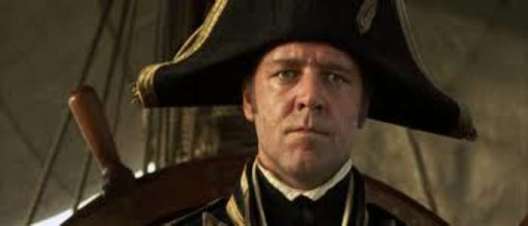
Master and Commander: The Far Side of the World (2003), Miramax Films.
Top Things to Remember About the First ActIf the Hook has done its job, you can safely slow the action to thoughtfully introduce and deepen your characters.The characters’ salient personality points, motivations, and beliefs should all be developed.The pertinent points of the initial setting must be fleshed out. Readers should already be oriented by the time the First Plot Point arrives.The readers’ bond with the characters helps raise the stakes. Make clear what the characters stand to lose in the coming conflict to drive the point home.Every scene must matter. Each scene is a domino knocking into the next domino/scene, building inexorably to the First Plot Point.Stay tuned: Next week, we’ll talk about the Inciting Event.
Wordplayers, tell me your opinions! Do you take the time to introduce your characters, settings, and stakes in your First Act? Tell me in the commentsRelated Posts:
Part 1: 5 Reasons Story Structure Is Important
Click the “Play” button to Listen to Audio Version (or subscribe to the Helping Writers Become Authors podcast in Apple Podcast, Amazon Music, or Spotify).
___
Love Helping Writers Become Authors? You can now become a patron. (Huge thanks to those of you who are already part of my Patreon family!)The post The First Act (Secrets of Story Structure, Pt. 3 of 12) appeared first on Helping Writers Become Authors.
July 22, 2024
The Hook (Secrets of Story Structure, Pt. 2 of 12)
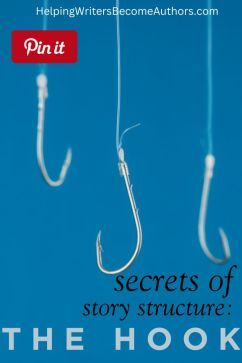 Readers are like fish. Smart fish. Fish who know authors are out to get them, reel them in, and capture them for the rest of their sea-going lives. Like all self-respecting fish, readers aren’t caught easily. They aren’t about to surrender to the lure of your story unless you present them with an irresistible Hook.
Readers are like fish. Smart fish. Fish who know authors are out to get them, reel them in, and capture them for the rest of their sea-going lives. Like all self-respecting fish, readers aren’t caught easily. They aren’t about to surrender to the lure of your story unless you present them with an irresistible Hook.
Naturally, our discussion of story structure begins at the beginning, and the beginning of any good story is its Hook. Unless you hook readers into your story from the very first chapter, they won’t swim in deep enough to experience the rest of your rousing adventure, no matter how amazing it is.
What Is the Hook?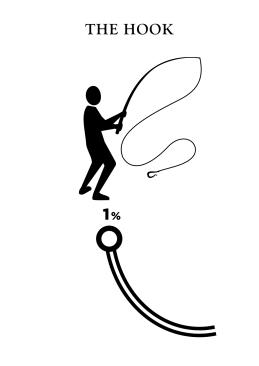
From the book Structuring Your Novel: Revised and Expanded 2nd Edition (Amazon affiliate link)
The Hook comes in many forms. Stripped to its lowest common denominator, it’s a question. If you can pique readers’ curiosity, you’ve got ’em. Simple as that.
The beginning of every story should present character, setting, and conflict, but in themselves, none of these are the Hook. You’ve created a Hook only when you’ve convinced readers to ask the general question, “What’s going to happen?” because you’ve also convinced them to ask a more specific question—e.g., “What scary reptilian monster killed the worker?” (Jurassic Park by Michael Crichton) or “How does a city hunt?” (Mortal Engines by Philip Reeve).
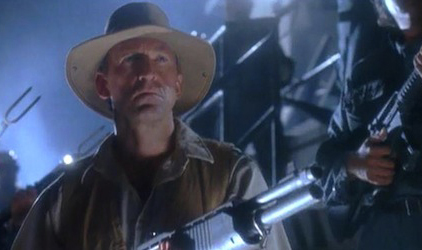
Jurassic Park (1993), Universal Pictures.
Writing a good opening scene can be tricky. Not only must you engage readers, you must do so with a scene element that creates and foreshadows everything to come. The most obvious way to do this is to think of the Hook as setting up cause and effect for the next thing that happens, which will create a new cause for a new effect, and so on throughout the story.
You can also go deeper by considering how the Hook operates within the larger pattern of story structure and how it relates to other structural beats. Particularly, consider how you can design a Hook that foreshadows the First Plot Point. As the first major turning point in the story, the First Plot Point (which ends the First Act and begins the Second Act about a quarter of the way into the story) is the first moment that requires significant foreshadowing.
It is important to understand the protagonist will not become inextricably engaged with the story’s main conflict until the First Plot Point. Because the First Plot Point is such a big moment in the story, it requires setup. The entirety of the First Act is about foreshadowing this moment. Therefore, although the Hook should be causally important in leading up to the First Plot Point, it will not likely involve the protagonist directly with either the main plot goal or the main antagonist. Rather, it will begin crafting the milieu and motive that will lead to those encounters. We will talk more about the First Act in next week’s post.
Foreshadowing in your story’s Hook need not be explicit. It can be as simple as setting the tone or, more practically, setting up the pieces that will set the main conflict into motion. The intent is to create a solid line of cause and effect beginning with the Hook and leading to the First Plot Point. This ensures your story’s opening will be pertinent and effective in pulling readers into your main plot.
 Another approach, which can be used simultaneously in some instances, is to start thinking about your story’s finale. The two halves of a story mirror each other, with the beats in the first half setting up and reflecting the beats in the second half (something I talk about in my book Next Level Plot Structure).
Another approach, which can be used simultaneously in some instances, is to start thinking about your story’s finale. The two halves of a story mirror each other, with the beats in the first half setting up and reflecting the beats in the second half (something I talk about in my book Next Level Plot Structure).
Consider what your story’s Resolution might be. How might the events of your story’s first chapter reflect the events of your last chapter? This might be very obvious in that the initial circumstances are entirely reversed by the end. It might also be that your character returns to the same setting in the end to witness how it has or has not changed. This mirroring can be extremely subtle and still be effective. At this point, you can use it merely to help inspire a solid beginning scene.
3 Techniques for Hooking ReadersYou can use many different techniques to create a Hook that both engages readers and sets up your story. Following are some of the most efficacious options, which can be used in combination with each other or any of a myriad other approaches.
1. Open In Medias ResIn medias res means “in the middle of things.” It describes the technique of creating a Hook that plunges readers right into the center of the action. The idea is to avoid the unnecessary throat-clearing of telling readers about the characters and the story world and to instead create a dynamic scene that shows readers who your characters are, what they want, and what kind of entertaining action they will be engaging in throughout the story. Depending on your story, the “action” may be fist fights and car chases, or it may be relational drama and witty banter.
There are many misconceptions about in medias res, particularly that it means cutting to the middle of the structural story with the protagonist already immersed in the main conflict. However, even in sequels that pick up wherever a previously developed plot left off, the full structure must still be present to create the story arc. The function of the Hook remains the same even in stories that begin with the intensity of the action already dialed to 10. The Hook will always set up and lead into the subsequent structural beats of the Inciting Event and First Plot Point, which in turn create the main conflict for this particular story.
2. Open With a Characteristic MomentIn most stories, the strongest opportunity to hook readers is the introduction of your protagonist. This central character should be the primary reason readers are interested in this story. You want to introduce your protagonist in a Characteristic Moment. This is a scene designed to show readers who this person is. In almost all instances, this does not mean showing readers your protagonist going through a normal daily routine. Rather, craft this scene around a scenario that shows readers how your protagonist reacts to an interesting and pertinent situation.
Not only should this situation initiate the line of cause and effect leading to the Inciting Event and then the First Plot Point, it should also showcase your protagonist’s pertinent strengths and weaknesses. If your protagonist’s wit or strength or kindness will be important to the story, create a scene demonstrating these traits. Likewise, if your protagonist’s shyness or short temper or moral grayness will be pertinent, showcase those. This is also your opportunity to introduce important and entertaining relationship dynamics, which will allow you to immediately get the dialogue flowing while also setting up crucial supporting characters.
3. Open with the Scene Goal/Conflict/DisasterWhen identifying the most interesting moment to begin your story, you can hack scene structure to help you choose. The three basic elements of scene structure are Goal, Conflict, and Disaster. Depending on your story, emphasizing any one of these aspects can help you find your story’s best Hook.
Opening with a scene goal can help you craft a solid Characteristic Moment, showing exactly what your protagonist wants. This can then tie into the larger plot goal that will develop later to inform your entire story’s throughline. Emphasizing the scene goal can also create an immediate sense of momentum for the scene, ensuring your protagonist starts out in motion, moving toward something.
However, if you instead choose to open later in the scene’s structure, you will automatically gain some benefits of in medias res. Beginning with the scene conflict allows you to skip right to the heart of the moment and show readers what type of action will be most prevalent in your story and how your protagonist deals with adversity. After getting into the action, you can then step back and offer any necessary information about what led to this moment.
 Finally, opening with the scene’s outcome means you’re opening even deeper in medias res, after the character has encountered difficulty in overcoming the conflict to reach the goal. Depending on the nature of your story, this outcome might be quite tense and exciting, but it might also simply offer context as you immediately introduce the character’s next goal.
Finally, opening with the scene’s outcome means you’re opening even deeper in medias res, after the character has encountered difficulty in overcoming the conflict to reach the goal. Depending on the nature of your story, this outcome might be quite tense and exciting, but it might also simply offer context as you immediately introduce the character’s next goal.
Learning more about scene structure (which I talk about in the second half of Structuring Your Novel) can help you decide which of these options might be best for your story’s Hook.
Where Does the Hook Belong?The Hook should be present as early as possible in your first scene. However, the hook must be organic. Teasing readers with a killer opening line (“Mimi was dying again”) only to reveal all is not as it seems (turns out Mimi is a Broadway actress performing her 187th death scene) not only negates the power of your Hook, it also betrays readers’ trust.
Stories contain many hooks. Indeed, you don’t want the impetus and curiosity created by one hook to die down without planting the next hook. This is true for every scene in your story. However, when we consider the Hook as a specific structural beat, we are talking about the first hook. Not only must the Hook pull readers into your story, it must also offer the first domino in the row of dominos that will create your plot.
The Hook takes place at the 1% mark in your story, the very beginning. A witty opening line can sometimes be enough to create the initial question that piques reader curiosity. However, don’t overvalue the opening line. Most stories use the opening line as part of an opening paragraph that plants the Hook in a more deliberate and leisurely manner. Depending on the pacing and tone of your story, you may even be able to introduce the Hook more slowly toward the end of the opening scene. This requires skill, since you have to trust readers to be patient enough to get that far.
Examples of the Hook From Film and LiteratureNow that you know what a structural Hook is and where it belongs, let’s consider a few examples. I’ve selected two movies and two novels to use as examples throughout this series so you can follow the story arc as presented in popular and successful media. Let’s look at how the professionals hook us so effectively we never realize we’ve swallowed the worm.
Pride and Prejudice by Jane Austen (1813): Austen begins by hooking us with her famous opening line:
It is a truth universally acknowledged, that a single man in possession of a good fortune must be in want of a wife.
The subtle irony creates a sense of conflict from the very first and hints that neither the wife in search of the fortune nor the man in search of the wife will reach their goals so easily. Austen deepens the pull of her Hook into her opening paragraph by further highlighting the juxtaposition of her opening statement with the realities of her plot. She deepens it still further throughout the opening scene, which introduces the Bennet family in such a way that we not only grow interested in them, but also learn both the thrust of the plot and the difficulties of the conflict.

Pride & Prejudice (2005), Focus Features.
It’s a Wonderful Life directed by Frank Capra (1947): Capra begins with a framing device that hooks viewers with a sneak peek of the Climax. The movie opens at the height of the main character’s troubles and has us wondering why George Bailey is in such a fix that the whole town is praying for him. Next thing we know, we’re staring at an unlikely trio of angels, manifested as blinking constellations. The presentation is not only unexpected, it succinctly expresses the coming conflict and stakes while engaging us with specific need-to-know questions.

It’s a Wonderful Life (1947), Liberty Films.
Ender’s Game by Orson Scott Card (1977):
The opening line to this award-winning science-fiction novel is packed with hooking questions:
I’ve watched through his eyes, I’ve listened through his ears, and I tell you he’s the one. Or at least as close as we’re going to get.
Just like that, Card has us wondering how the speaker is watching and listening through someone else’s mind. Who is “the one”? What is “the one” supposed to do? And why are they settling for a “one” who is less than perfect? Card then builds into a scene that introduces his unlikely hero, six-year-old Ender Wiggin, just as his life is turned upside down.

Ender’s Game (2013), Lionsgate.
Master and Commander: The Far Side of the World directed by Peter Weir (2004): As a brilliant adaptation of Patrick O’Brian’s beloved Aubrey/Maturin series, this film is unorthodox in many ways, not least in its non-formulaic tone and plot. Nevertheless, it demonstrates structural integrity, beginning with a stark opening that shows the morning ritual aboard the man-of-war HMS Surprise. Aside from arousing our natural curiosity about the unique setting, the Hook doesn’t appear until a minute or so into the film when one of the midshipmen spots what might be an enemy ship. The film carries viewers through a few tense moments of uncertainty and indecision, then, almost without warning, plunges them into a horrific sea battle. We are hooked almost before we see the Hook coming.

Master and Commander: The Far Side of the World (2003), Miramax Films.
Top Things to Remember About the HookHooks should be an integral part of the plot.Hooks don’t always involve action, but they always set it up.Hooks never waste time.Hooks almost always pull double or triple duty in introducing character, conflict, and plot—and even setting and theme.Your Hook is your first chance to impress readers. Plan your Hook carefully and wow readers so thoroughly, they will never forget your opening scene.
Stay tuned: Next week, we’ll talk about the First Act.
Wordplayers, tell me your opinions! What Hook begins your story structure? Tell me in the comments!Related Posts: Part 1: 5 Reasons Story Structure Is Important
Click the “Play” button to Listen to Audio Version (or subscribe to the Helping Writers Become Authors podcast in Apple Podcast, Amazon Music, or Spotify).
___
Love Helping Writers Become Authors? You can now become a patron. (Huge thanks to those of you who are already part of my Patreon family!)The post The Hook (Secrets of Story Structure, Pt. 2 of 12) appeared first on Helping Writers Become Authors.
July 15, 2024
5 Reasons Story Structure Is Important (Secrets of Story Structure, Pt. 1 of 12)
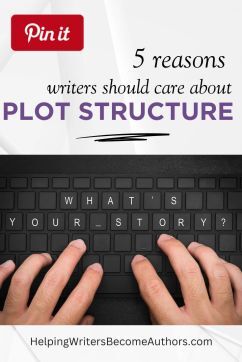 What’s the single most overlooked, misunderstood—and yet important—part of storytelling? If you read the post title, you already know the answer is story structure.
What’s the single most overlooked, misunderstood—and yet important—part of storytelling? If you read the post title, you already know the answer is story structure.
Twelve years ago, I shared the series “Secrets of Story Structure” on this site. That series became the basis of one of my best-known writing-craft books, Structuring Your Novel. That original series and the book that followed were founded upon my journey as a writer, particularly my burning need to understand how story worked. What is story anyway? And which principles and patterns could show me how to write stories that hung together, created seamless arcs, and, most importantly, resonated with readers?
Like most young authors, I was eventually told the answer to all these questions was “structure.” When I began exploring what that meant, I had no idea how monumental a journey I had just embarked on. I expected story structure to teach me how to write great stories. What I didn’t foresee was that it would also change my entire perspective of life itself.
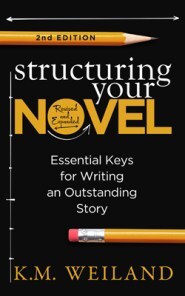
Structuring Your Novel, 2nd Edition (Amazon affiliate link)
My basic question, “What is story, anyway?” had a much bigger answer than I anticipated. This is because, of course, story is life itself. Story is a reflection of the cyclical patterns and psychological arcs we experience throughout our lives. When we examine the structural patterns that create resonant stories, what we find are the landmarks of life itself.
When we structure a story, we are trying to create a faithful facsimile of real life. This is what grounds a story’s verisimilitude, whether it is hyper-realistic modern fiction or the most fantastical and archetypal of fairy tales. The foundation of solid story structure allows audiences to suspend disbelief and identify with the story world, even if that world is filled with bizarre and unfamiliar details.
Writers often discuss story structure as if it were something we arbitrarily impose upon a story when really just the opposite is true. What we call “story structure” is the shape of life itself. As writers, it is our job to uncover this shape from within our story ideas and to polish it until it touches a point of universal resonance within every member of our audience, no matter how different they may be from us or from each other. Although the simplicity of certain plot beats, by themselves, are not enough to achieve this crystalline resonance, they are the first step.
Writers initially come to story structure for many reasons. Sometimes it is with the explicit purpose of creating that crystalline resonance. More often, it is because we’re trying to write something entertaining, realize we have no idea how to do it, and want guidance. Whatever the case, story structure offers writers a roadmap to writing solid plots. It lays the groundwork for compelling character arcs and themes, taps into the resonance of the collective consciousness, and even deepens our understanding of life.
Although the foundational principles I shared in the original version of this series remain the same, I have learned so much about both stories and life in the past twelve years. I felt it was time to revisit the incredible importance of this information, to polish its rough spots, to add new information, and to correct a few areas where I have refined my perspectives.

Next Level Plot Structure (Amazon affiliate link)
I was inspired to revisit this series and, for those who prefer the book experience, to create a revised and expanded second edition of Structuring Your Novel (the book teaches scene structure too). I have also just released a “sequel” Next Level Plot Structure, which goes even deeper into principles of story theory, chiastic structure, and the deeper meaning and purpose of important structural beats. I hope you will enjoy joining me over the next few months as we update this important series and take a deep look into the secrets of story structure. My wish is that you will be able to use this fundamental knowledge to write easier, better, and deeper stories!
What Is Story Structure?Most uninitiated writers have two different reactions to the idea of story structure. Either they think it’s great but too mystical and lofty to be understood by common mortals. Or they think it’s formulaic hooey that will sap the art right out of their books.
I started somewhere in between—in the “huh?” camp that didn’t even realize there was such a thing as structure. From there, I progressed to reading complicated outlines that left me shaking my head. If that was structure, then it seemed my story would practically be written for me before I even came up with a decent idea. Thanks, but no thanks.
What I didn’t know is that even as I subjected the idea of story structure to my ignorance and ridicule, I was already structuring my stories without even realizing it. In the following years, I was introduced to many theories of structure representing the inevitable components found in good stories whether their authors deliberately structured them or were just lucky enough to wing it on their own good instincts.
The macro level of story structure that I present in this series is a happy medium of the two: ten plot beats that, when arranged correctly, give both authors and readers the biggest bang for their buck.
Foundational story structure creates nothing more than the arc of a story. It does not tell the writer what events must happen at certain beats, only what those beats need to represent to create a functional arc. Although specific beat sheets can sometimes be helpful (especially when dealing with genre formulae), this over-specification can distract from the beautiful simplicity of what story structure really is.
And what is it?
1. Story structure creates a foundation for the plot that mirrors the arc of psychological transformation. It ensures the story contains all the pieces required to make sense while eliminating the temptation to create redundancy.
2. Story structure creates pacing. Standard plot beats divide the story into eight (ideally) equal parts. Although structural timing will be stressed throughout this series, what is most important to understand is that it exists to create pacing, which in turn exists to control the audience’s experience of the story—to keep them engaged and invested in every moment.
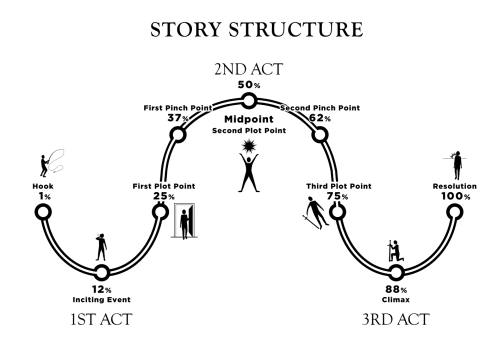
From the book Structuring Your Novel: Revised and Expanded 2nd Edition (Amazon affiliate link). Graphic by Joanna Marie Art.
Over the next eleven weeks, we will be exploring, beat by beat, the most important moments in story structure:
The First Act (1%-25%)
1. The Hook (1%)
2. The Inciting Event (12%)
3. The First Plot Plot Point (25%)
The Second Act (25%-75%)
4. The First Pinch Point (37%)
5. The Midpoint – Second Plot Point (50%)
6. The Second Pinch Point (62%)
The Third Act (75%-100%)
7. The Third Plot Point (75%)
8. The Climax (88%)
9. The Climactic Moment (99%)
10. The Resolution (100%)
5 Reasons Story Structure Is ImportantOver the next few months, we will explore the mysteries, fallacies, and opportunities of story structure. For now, let’s consider a few reasons every author should care about structure and why none of us should fear it.
1. Structure Is Required in all of ArtDancing, painting, singing, you name it—all art forms require structure. Storytelling is no different. To bring a story to its full potential, authors must understand the form’s limitations and how to arrange its many parts in the proper order to achieve maximum effect.
2. Structure Does Not Limit CreativityAuthors sometimes fear story structure will inhibit their creativity. If your book follows a specific road and observes certain pit stops, won’t the story be written for you? This is not the case. Structure presents only a shape—the curve of the story arc. It allows us to be concrete and confident in creating that arc, ensuring its effectiveness.
3. Structure Is Not FormulaicAnother fear is that if every story has the same structure, won’t every story ultimately be the same? This isn’t any truer than is the idea that because every ballet incorporates the same movements, every ballet must be the same. Structure is only the box that holds the gift. What that gift may be varies as wildly as the wrapping paper that hides it.
4. Structure Offers a Checklist of Must-Have ElementsDon’t we read how-to books (and blogs like this one) because we want to discover and remember all the elements that make up a successful story? Structure is nothing more than a list of those elements organized in one tidy package.
5. Structure Solidifies Mastery of the CraftLearning to consciously understand the techniques you’re probably already instinctively using will broaden your understanding and tighten your mastery of the craft. When I first discovered the intricacies of structure, I was amazed to realize I was already incorporating most of the elements in my stories. Learning about these elements allows you to strengthen your raw creative instinct into purposeful knowledge.
***
Ready to open up a whole new world of storytelling? Structure is exciting, comforting, and liberating all at once. Whether you’re discovering the ins and outs of story structure for the first time or just brushing up, I hope you’ll enjoy our journey into the most salient and crucial moments in the creation of a story.
Stay tuned: Next week, we’ll talk about the Hook.
Wordplayers, tell me your opinions! How do feel about the idea of story structure? Tell me in the comments!Click the “Play” button to Listen to Audio Version (or subscribe to the Helping Writers Become Authors podcast in Apple Podcast, Amazon Music, or Spotify).
___
Love Helping Writers Become Authors? You can now become a patron. (Huge thanks to those of you who are already part of my Patreon family!)The post 5 Reasons Story Structure Is Important (Secrets of Story Structure, Pt. 1 of 12) appeared first on Helping Writers Become Authors.
July 8, 2024
Launch Day! Two New Books for Writers (+Win a Freewrite Alpha!)
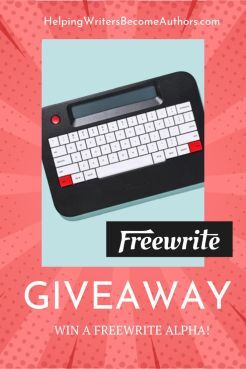 Hooray! Today, I am so happy to be sharing with you not one but two book launches—a revised and expanded second edition of Structuring Your Novel and a brand-new “sequel” Next Level Plot Structure. (And be sure to check out the giveaway for a Freewrite Alpha at the bottom of the post.)
Hooray! Today, I am so happy to be sharing with you not one but two book launches—a revised and expanded second edition of Structuring Your Novel and a brand-new “sequel” Next Level Plot Structure. (And be sure to check out the giveaway for a Freewrite Alpha at the bottom of the post.)
If you want to write a story that works (and that doesn’t have you pulling out an unreasonable amount of hair), plot structure is the foundation upon which everything is built. Once you learn to recognize and understand the structural underpinnings that create a story’s arc, you can turn your imagination loose on your own stories, “knowing that you know” what you’re doing.
Structuring Your Novel is one of the most important books I have ever written. It was based on my cornerstone blog series “Secrets of Story Structure,” which I will be re-publishing starting next week (so if you’ve already read the first edition, you can catch up on the most important updates for free).
Structuring Your Novel continues to be one of the books I hear about most often from writers who are celebrating their successes in finishing and publishing manuscripts. When the book reached its official ten-year anniversary last year, I was inspired to revisit it, to update some information, add three new chapters (on the Inciting Event, Midpoint, and Third Plot Point), and just generally spit and polish it up a bit.
While working on the second edition, I realized how much I’ve learned about structure in the past decade. I wanted to share the nuances, theories, and understandings of structure that have helped me fall even more in love with story and to understand how and why plot structure works on a deeper level. However, because Structuring Your Novel has become such a mainstay for so many writers (80,000 and counting at this point!), I didn’t want to change it too much. So I decided to create a sequel!
Next Level Plot Structure compiles my last decade’s worth of discoveries and teachings about story theory and plot and scene structure. Specifically, it looks at how all of structure—from the macro level to the micro—can be constructed as two halves that mirror each other.
Not only does this create built-in foreshadowing and solid plots with cohesive set-ups and pay-offs, it also offers incredible opportunities for deepening character arcs and leveraging the built-in symbolism and meaning found within the plot beats themselves.
I am so happy to celebrate the second edition of Structuring Your Novel with all of you. Thank you for embracing it and making it a part of your writing journeys for the past decade! And I am ecstatic to get to share Next Level Plot Structure as a thoroughly up-to-date exploration of all my favorite ways to write stories that explode off the page and screen to remain with audiences for their entire lives. I can’t wait to hear about the new stories you will write with these books!
Where Can You Buy The BooksYou can purchase Structuring Your Novel (Revised and Expanded 2nd Edition) at the following links:Amazon USA e-book (affiliate link)Amazon USA paperback (affiliate link)Amazon UKAmazon CanadaAmazon AustraliaAmazon JapanKoboBarnes & NobleApple BooksEpub Direct From My SiteIf you have already read the first edition, I would totally appreciate it, if you’d consider leaving a review on the new one! Creating a new edition meant losing the thousands of reviews the book collected over the past decade. I would totally appreciate it if you’d help me rebuild the review section!
Also, in case you’re wondering, I am planning to update and create a second edition of the Structuring Your Novel Workbook next year sometime.
You can purchase Next Level Plot Structure at the following links:Amazon USA e-book (affiliate link)Amazon USA paperback (affiliate linkAmazon UKAmazon CanadaAmazon AustraliaAmazon JapanKoboBarnes & NobleApple BooksEpub Direct From My Site(Audiobooks are hopefully coming later this year!)
More About Structuring Your Novel (Revised and Expanded 2nd Edition)Is Structure the Hidden Foundation of All Successful Stories?
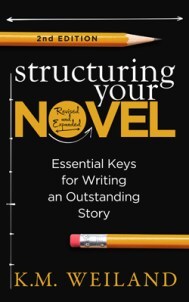 Why do some stories work and others don’t? The answer is structure. In this 10-year anniversary edition, you will discover the universal underpinnings that guarantee powerful plot and character arcs. An understanding of proper story and scene structure will help you to not only perfectly time your story’s major events, but will also provide you with an unerring standard to use in evaluating your novel’s pacing and progression.
Why do some stories work and others don’t? The answer is structure. In this 10-year anniversary edition, you will discover the universal underpinnings that guarantee powerful plot and character arcs. An understanding of proper story and scene structure will help you to not only perfectly time your story’s major events, but will also provide you with an unerring standard to use in evaluating your novel’s pacing and progression.
Structuring Your Novel will show you:
How to recognize and create powerful plot points at the right moments throughout your story.How to determine the best methods for unleashing your unique and personal vision for your story.How to identify common structural weaknesses and flip them around into stunning strengths.How to eliminate saggy middles by discovering your “centerpiece.”Why you should NEVER include conflict on every page.How to craft a solid line of amazing scenes that create your story’s dramatic arc.Revised and expanded with updated information and three brand new chapters, this second edition will help you join legions of writers who have learned how to write masterful plots.
Story structure has empowered countless bestselling and classic authors. Now it’s your turn!
More About Next Level Plot StructureElevate Your Storytelling with Expert Plot Structure
 Unlock the secrets of compelling storytelling with Next Level Plot Structure, a brand-new guide from K.M. Weiland, author of the popular Structuring Your Novel. This comprehensive resource delves deep into the intricacies of plot structure, revealing the rich vein of narrative techniques and philosophical underpinnings that have shaped storytelling throughout history.
Unlock the secrets of compelling storytelling with Next Level Plot Structure, a brand-new guide from K.M. Weiland, author of the popular Structuring Your Novel. This comprehensive resource delves deep into the intricacies of plot structure, revealing the rich vein of narrative techniques and philosophical underpinnings that have shaped storytelling throughout history.
Whether you’re a seasoned writer or just starting out, Next Level Plot Structure provides invaluable insights and practical techniques to help you take your storytelling to new heights.
Enter to Win
To celebrate the launch of Structuring Your Novel and Next Level Plot Structure, I am giving away a Freewrite Alpha (value $349).

Description of Freewrite Alpha:
Alpha is a dedicated drafting device for anyone who wants to write without the distraction—or temptation—of browsers, email, or notifications.
Get in writing flow and develop more prolific writing sessions by separating the drafting and editing processes. When it is time to edit, your drafts wirelessly sync to the cloud for export into your software of choice.
Push your productivity forward and tap into writing joy.
To EnterWinners will be announced Monday, July 15th (via email and on Instagram). Enter below! (Note: no purchase is necessary to enter.)
Good luck to everyone in the drawing, have fun, and thank you for helping me celebrate the launches of Structuring Your Novel and Next Level Plot Structure!
Click the “Play” button to Listen to Audio Version (or subscribe to the Helping Writers Become Authors podcast in Apple Podcast, Amazon Music, or Spotify).
___
Love Helping Writers Become Authors? You can now become a patron. (Huge thanks to those of you who are already part of my Patreon family!)The post Launch Day! Two New Books for Writers (+Win a Freewrite Alpha!) appeared first on Helping Writers Become Authors.
July 1, 2024
Everything You Need to Know About the Lie the Character Believes
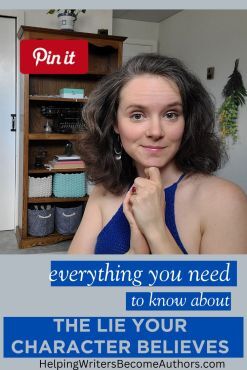 Hello, everyone, and welcome! In today’s post/podcast/video, we’re going to be talking about what is very possibly the single most important element of any successful story. And that is the Lie the Character Believes.
Hello, everyone, and welcome! In today’s post/podcast/video, we’re going to be talking about what is very possibly the single most important element of any successful story. And that is the Lie the Character Believes.
The Lie the Character Believes is a mistaken or limited perspective the character holds at the beginning of the story which will be challenged as they go through the plot. In some stories, they will overcome it in exchange for a thematic Truth, which is a broader and more expanded perspective of themselves or the world around them.
In other stories, they may fail to see past the Lie, in which case, they’d be arcing negatively probably into a worse Lie.
It’s also possible they start out in possession of the Truth, and it’s the world around them that represents the Lie. They are able to use their broader understanding of something to bring more refinement and calibration to the characters in the world around them. This is a Flat Arc.
Fundamentally, it is this push-pull—this conflict between the Lie and the Truth—that creates character arc. It creates change within the character. By doing that, it also drives the plot and is driven by the events of the plot.
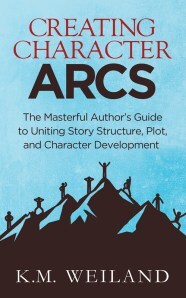
Creating Character Arcs (Amazon affiliate link)
This is something that I discussed in depth in my book Creating Character Arcs. If you want more information than what we’re going to talk about in this 20-minute video transcript, then you can check out the book.
What Is the Lie Your Character Believes?To start with, let’s talk about what is the Lie and what is the Truth.
I like these terms because they are very black and white. They immediately give you a sense of their deeper archetypal purposes within a story.
However, it’s important to understand that both can be very relative within the story. Fundamentally, all the the Lie is is a limited perspective. It’s something the character believes to be true about themselves or the world. It may be true to a certain point. But it’s limited. The events of the story—whatever is happening that’s asking them to step up within the plot—is challenging this limited perspective. The events of the plot indicate that this old perspective is no longer good enough. It isn’t going to get the job done anymore.
What is the Thematic Truth?
Writing Your Story’s Theme (Amazon affiliate link)
The thematic Truth stands in opposition to the Lie as something the story is positing is “more” true about the world than this limited perspective with which the character starts out. I call it the thematic Truth because theme in a story is whatever this story ultimately is consciously or unconsciously trying to prove about reality.
Sometimes the thematic principle will be very explicit, as when the character learns some sort of aphorism or axiom like the golden rule or something like that. Other times, the thematic Truth is never outright stated within the story. It’s just proven through what is effective in the character’s actions as they move through the plot.
In a very plot-driven story, the Truth may be simply that the character needs to learn something—“e.g., you need to learn Kung Fu in order to defeat the bad guy.” They need to learn this new way of being in the world, this new skill. Or they may need to learn something like “Darth Vader is your father.” They need to perceive something that is mistaken about how they are interacting with the information they need in order to reach the plot goal.
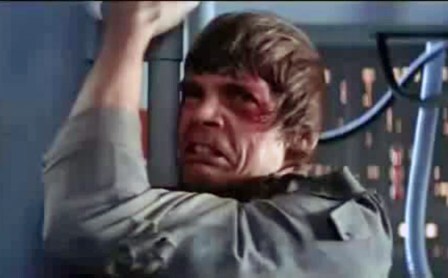
Star Wars: The Empire Strikes Back (1980), 20th Century Fox.
In other stories, the needed Truth is much more personal and can be hard to define in concrete terms, such as “you are worthy” or “you are lovable.”
How Your Plot Proves Your Story’s Thematic TruthWhatever the Truth is in your story—and therefore whatever the theme is—has to do with what the story proves works for the characters. The story will posit that the Truth is a more effective way of thinking about and being in the world. This is then proven by how the characters are able to move toward their plot goal and whether or not they achieve it.
If they’re effective in reaching their plot goal by the end, that indicates they were able to overcome the limitations of the Lie and move into this more expanded and effective perspective of the Truth.
If they’re in a Negative Change Arc, they will end up being ineffective in the plot in some way. Even if they’re able to gain their plot goal, there’s some sort of moral failure or defeat because they were not able to grasp the Truth. Even in stories in which the Truth doesn’t “win”—as when the characters are not able to use it to get what they want or to be more whole within themselves in the story world—it still prove sitself by the very fact that they’re not happy or they’re not effective or that they fatally compromised their integrity in some way.
Every story–whether it’s plot-driven or character-driven—will revolve around some level of this conflict between Lie and Truth, between a limited way of being and a more expanded and effective way of being within the story.
How to Create a Character Arc Using the Lie and the TruthTo create a character arc, you start out with a character believing a Lie—a limited perspective. What it is will depend on what you’re trying to explore in your story. It can be many different things, but regardless, they will start out with this limited perspective.
Then, as the plot kind of rolls into view, something happens. The Inciting Event comes online, and the characters’ reality begins to change. That’s the whole point of why you’re beginning this story at this moment, or why you’re telling this story at all. Something’s happening—something’s changing within the character’s reality—that is going to challenge their perspective of the world and of themselves. Their old perspectives will no longer be as effective as they may once have been.
The character begins to experience inner conflict as they try to grow into the person they need to be to meet these plot challenges coming at them.
Character Arc in the First Act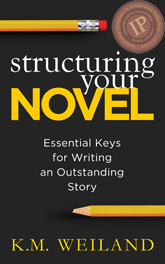
Structuring Your Novel (Amazon affiliate link)
Generally speaking, the First Act (the first 25% of the story) is where you’re really going to be exploring the Lie. This is where you’re exploring what this looks like for the character, how it may have been effective for them up until this point, and also how they’re developing a new plot goal in response to the changes that have begun happening.
This is where you can start exploring the dysfunction of the Lie and why it will no longer prove effective as they move forward. You can explore why they need to change—in essence why they need to accept that Call to Adventure to change, so they can become more effective as they move through the plot.
Character Arc in the First Half of the Second ActAs the character enters the Second Act (the middle 50% of the story), after the First Plot Point, they enter that threshold through the Doorway of No Return, and they enter the full-on conflict of the Second Act.
The first half of the Second Act is very much about the characters reacting to everything that’s changing. They’re a little bit off balance. The primary reason for this is they don’t have an understanding of the Truth yet. Right. They’re still trying to operate out of their old mindset—the Lie. However, what has been their perspective and mode of being up until this point actually isn’t effective to meet these new challenges.
This is what I call a “grumpy-bumpy” period, where you’re growing and everything feels uncomfortable. You don’t quite know what’s going on. You’re maybe not completely embracing the process. You’d rather just stick with your old way of being and keep pretending. You have a hammer, and so you think all the world’s a nail. The point of this story is that the character is meeting challenges that are not nails. These problems are bigger than what they’ve ever encountered before. Slowly, it starts to dawn on them that the old way of doing things is not going to work.
This is a time in the plot when they’ll be running into defeats—maybe not definitively, but as they try to use their old perspective, it doesn’t completely work. It’s not completely effective. They have to adjust and learn as they go.
Character Arc at the MidpointAs they slowly began to explore the limitations of the Lie, it begins to dawn on them that maybe this old perspective isn’t the end-all-be-all of how to see things. That will bring them to the Midpoint, which is defined by what I call the Moment of Truth. This is a moment where something big happens, and the accumulation of everything the character has been learning leads them to really see the opposing viewpoint. They see the story’s thematic Truth and how effective it could help them be in getting what they need.
Basically, a light bulb goes on and they’re like, “Oh, this is what I have to do to get what I want.” In some stories, it’s as simple as that. The Moment of Truth can be simply a plot revelation like, “Oh, we need to go find the plans to the bad guy’s evil base, because that’s going to let us get what we want!” It can be something very practical and action-based.
However, specifically within theme and within character arc, the Moment of Truth will also a deeper understanding and expansion within the person. They have to be able to see something in a way they’ve never seen it before and to expand into that. It’s challenging them to become a new version of themselves in some way.
Even though the characters recognize the Truth at the midpoint, they do not yet reject the Lie. Basically, get this shiny new toy, and they’re like, “Oh wow, I totally get it! This is amazing! I’m going to be awesome from this point on!” But they’re not yet willing to totally give up who they were before or their old modes of being.
This could be for ego reasons (i.e., they’re very identified with whatever it is), but it could also be just for survival reasons. They might be thinking, “This is how I’ve always survived. I can’t let this go yet.” That’s not necessarily an inaccurate perspective because they haven’t yet fully integrated the new way of being. If they just let go of the old way too soon, then it could be very destructive, depending on what it is. So they continue to hang onto the Lie.
Character Arc in the Second Half of the Second ActFrom this point on, they can take this Truth they gleaned at the Midpoint and move into the second half of the Second Act, which is very much an action phase. They’re able to move out of that hapless reaction where they don’t know what they are doing or quite how to get it done. Now, they become more and more effective as they go.
It’s likely the antagonistic force will also be pushing harder and getting bigger. In this section of the story, the protagonist won’t necessarily be “winning” in the conflict, but they are learning how to become much more effective by using a more accurate understanding of the conflict and of themselves in that conflict.
Throughout the second half of the Second Act after the Midpoint, they begin to move more and more into the Truth. But they’re experiencing this inner conflict between Truth and Lie, feeling like, “How can I hold these two perspectives or ways of being at the same time?”
Character Arc in the Third ActIt becomes clearer and clearer the Lie and the Truth are in fact incompatible and that the character is probably going to have to let go of the Lie completely at some point. That is going to lead them to the Third Plot Point, which is the Low Moment. It symbolizes death/rebirth within the story.
Specifically on the level of character arc, what’s happening here is that if the character is to succeed in achieving a Positive Change Arc and embracing the Truth, then the person they used to be—the person who believed in the Lie—is going to have to die. That old identity is kaput at this point. If they’re going to succeed, they’re going to have to be reborn into this person who is fully integrated and embraces and understands the Truth of the story.
It is important to remember, that in the most poignant stories, this is usually a very complex moment. When we hear the words “Lie” and “Truth,” we think, “Well, obviously we want the Truth. Why would we hang on to the Lie?” But in our own lives and therefore what we want to see mirrored in story isn’t this simple.
Up to now, the Lie has been like an old friend. Even though it’s comparatively limited, this perspective has been effective to some degree. Therefore, we’re kind of loath to give it up. We’re identified with it on an ego level to some degree. To give up the Lie does feel like, “I’m giving up myself. I’m giving up a part of myself—my old way of being.” In a story, this sacrifice is definitive. So there is a death of some part of the character and therefore a grief and a very real desire to hang on to the old way of being and not let it go.
The character is met with a moment where their refusal or inability to completely give up the Lie will lead them to what maybe seems like a victory at first. But it is ultimately a defeat of some sort. It becomes very clear the defeat is the consequence of their refusal to completely give up the Lie. They will not be able to overcome this defeat or reverse it or finally get what they want or become who they want to be unless they finally and fully grapple with this old identity and give up the Lie.
This can be dramatized very quickly. It doesn’t have to be this huge trip into the underworld of the character’s psyche where they’re wrestling with these parts of themselves. But it needs to be hit full-on. Don’t just brush over it. This is arguably the most potentially powerful moment within your entire story. This is it. This is where the character’s arc is decided. Are they going to be able to do this? Are they going to be able to transition into someone who believes in and embraces and embodies this story’s new Truth?
Character Arc in the ClimaxA good portion of the Third Act often is taken up with this inner conflict and this grappling. Then the Climax will start about halfway through the Third Act.
By the time the character gets to the Climax, they may not be crystal clear about exactly what’s happening or what they’re going to do. But they will have integrated the Truth (if they’re going to integrate it within this story) and rejected the Lie. They haven’t acted upon the Truth yet—it’s unproven at this point—but it’s there. It’s ready for them to do whatever they’re going to do in the Climax—to make that climactic decision, to be a stand for the story’s Truth, to use the story’s Truth to allow them to be effective as they move against the antagonistic force or toward their plot goal.
By the time they get to the Climax, the conflict is pretty much decided. What’s left is for them to act upon it, to prove it to themselves and to readers and to see what happens when they embrace the Truth—or vice versa, what happens when they reject it. What are the consequences either way?
That’s character arc—this dance between the Lie and the Truth within a story. This is such an important foundation to understand within story theory and story structure. Character arc and story structure are very much connected. You can’t have plot without character and vice versa.
So this transformation in this ongoing conflict between Lie and Truth is as important to plot as it is to character. It will be found in any type of story, even if it doesn’t go deep into the character arc, even if it doesn’t sketch a huge dramatic character arc or doesn’t spend a lot of time on the character arc. Regardles, the underpinnings are still there and exist within the plot structure.
Examples of Different Kinds of Lies the Character BelievesLet’s close with examples of different kinds of Lies. Again, the terminology “Lie” and “Truth” is very black and white. I like these terms for that very reason because it grants an immediate sense of what they are and their dynamic within the story. But, in fact, they are not that black and white. They are very, very relative. Particularly, I think we hear “Truth,” and we think “ultimate truth.” That can be what you’re dealing with in your story, but in most stories, all you’re dealing with is a viewpoint that is “better” than the Lie.
Fundamentally, what is the Lie?
1. Literal Lie on a Personal LevelIt can be a literal Lie the character is dealing with at some level. Maybe they were lied to. Fore example, maybe they were adopted but they were told that they were their adopted parents’ biological child.
2. Literal Lie on a Social LevelThe Lie could also be on a grander scope. Maybe you’re dealing with a government conspiracy or a cover-up.
3. Lie as a Lack of InformationMurder investigations, in essence, are a search for the Truth to overcome the Lie–in which case the Lie is really just a lack of information about who the killer may be. That’s a very plot-based example of how this works.
3. Lie as a Misconception About the WorldIn other stories, the Lie likely to be something deeper. Even if there is a surface example of how it’s playing out in the world, there is also this deeper wrestling within the character of a misconception they hold either about the world around them. For example, perhaps they have a view that a certain type of people are evil and they have to overcome that. Or perhaps they have a view that people in general are unsafe or something like that. And they have to overcome that view in order to, for instance, be more effective in a relationship.
4. Lie as a Misconception About the SelfThe Lie can also be a misconception the character hold about themselves. Social and personal misconceptions can be held mutually. Very often, when we have a view about the world, it’s because we are projecting something from within ourselves onto other people in the world around us.
At its most psychologically valuable, the Lie the Character Believes is a lack of wholeness within the character. It’s a shadow piece. This is something I’ve talked about in my recent course about Shadow Archetypes. Really, the inner conflict is this wrestling with the potential we have within ourselves to claim this new Truth versus the personal shadows that would pull us back or pervert this new power into something that isn’t positive or integrated for ourselves or others.

Creating Character Arcs Workbook
At its deepest level, the Lie the Character Believes is usually some belief they hold about themselves and how they operate in the world. For example, they aren’t good enough or they aren’t worthy or they need a certain status symbol in order to be okay. There are many examples. I talk about this in my book Creating Character Arcs (and the Creating Character Arcs Workbook), so you can look there for some more examples.
***
Ultimately the Lie the Character Believes is something foundational to who they are and how they’re operating in the world at the beginning of the story. That will be challenged by the events of the story. They’re going to have to work through the Lie in order to come to the place where they are integrated and effective in the story world.
Wordplayers, tell me your opinions! What is the Lie Your Character Believes? Tell me in the comments!Click the “Play” button to Listen to Audio Version (or subscribe to the Helping Writers Become Authors podcast in Apple Podcast, Amazon Music, or Spotify).
___
Love Helping Writers Become Authors? You can now become a patron. (Huge thanks to those of you who are already part of my Patreon family!)The post Everything You Need to Know About the Lie the Character Believes appeared first on Helping Writers Become Authors.
June 24, 2024
Juggling Life and Writing: 9 Tips for Maintaining Creative Focus
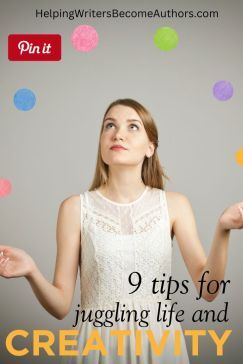 Balancing the pursuit of creative writing with the demands of daily life is a nuanced challenge. Juggling life and writing isn’t easy without strategies that can help us maintain creative focus amid life’s myriad distractions. Whether you’re dealing with the pressures of work, familial responsibilities, or the never-ending lure of digital devices, writers everywhere face challenges in safeguarding creative time. Writers need tools that help them nurture their creativity while also gracefully handling life’s interruptions. Discovering strategies for maintaining creative focus can help you craft a fulfilling writing experience even in the face of life’s surprises.
Balancing the pursuit of creative writing with the demands of daily life is a nuanced challenge. Juggling life and writing isn’t easy without strategies that can help us maintain creative focus amid life’s myriad distractions. Whether you’re dealing with the pressures of work, familial responsibilities, or the never-ending lure of digital devices, writers everywhere face challenges in safeguarding creative time. Writers need tools that help them nurture their creativity while also gracefully handling life’s interruptions. Discovering strategies for maintaining creative focus can help you craft a fulfilling writing experience even in the face of life’s surprises.
One of the most common frustrations of any writer’s life is how difficult it can often be to find time to actually write. For those with other jobs that pay the bills or family responsibilities, writing time can slip away all too easily. Even those who write full-time discover their time can get eaten up just as quickly with the same time-management problems as before, not to mention the demands of the business side.
What’s a writer to do? Reader Colleen F. Janik asked for tips, saying:
How in the world do you manage to stay on track with your books and not allow life to get in the way? There are so many unexpected events involving family members, friends, moving from one location to another. I have books that have been left far behind me in a trail of dust and rubble.
9 Tips for Juggling Life and WritingColleen is not alone. Personally, I have lamented throughout my life that there wasn’t just one more hour in the day. And yet every time I juggle my schedule around to find an extra hour, I end up with the same lament sooner than later. Even when you think writing is one of your top priorities, it is shockingly easy to see it slip so far down on the to-do list that days or even weeks pass before you find yourself back at your desk. Cue the frustration and the guilt.
There is no quick fix. But there are many perspectives and habits we can cultivate on a daily basis so their effects multiply over time, even when life is at its most demanding and chaotic. Here are nine tips to get you started.
1. Don’t View Life and Writing as SeparateThis one is important. So often we mentally divide everything that happens to us into different categories. There is Writing, and then there is Job, Family, Health. Whatever is left, we then tend to leave in the big lump that is simply Life. Ironically, the Life pile is the one we often tend to feel we are missing out on. But Life is all there is, my darlings. All the other categories are arbitrary distinctions we use to help us get organized. Although bringing a sense of order to our minds is always a good thing, our vision can become so narrow we miss the forest for the trees.
When we despair of juggling life and writing, we’re operating in a dualistic mindset that wants to separate the writing (or whatever else) from the life. When something other than writing happens, we suddenly feel we’re off-track. When we get the opportunity to move to a new state or we set aside time to celebrate a family member’s marriage or we confront a health crisis—it can feel like we’ve failed in maintaining our writing goals. Operating from such a sum-zero mindset suggests that to succeed at one thing (even if it is just facing what is necessary) means to fail at something else. This creates totally unnecessary pressure.
This is not to say schedules can’t be refined and better habits can’t be cultivated. But we might do better to release the idea that we have to control life if we’re ever going to be successful at prioritizing our writing. If we give ourselves the opportunity to open ourselves to the true flow of creativity, we realize it is operating not just when we’re at our desks, but in every surprising moment of every day.
2. Identify Your Pain PointsReally the entire challenge of juggling life and writing is about coming into flow with ourselves. One of the first steps is to consciously map whatever is creating resistance that blocks our ability to keep writing effortlessly within the the flow our daily schedules.
Start by identifying your pain points. What do you feel is obviously blocking your ability to be consistent with your writing time? The answers may be big events that are currently demanding huge chunks of your time and attention. But the answers may also focus on little things, like giving in to the temptation of social media or being too tired in the evenings to write even though you do have time then.
Make a list. It can help to imagine what your ideal day would like—one where making time for writing would feel effortless. What exists in your real life that is notably missing from this ideal day? Those are probably your most potent pain points.
3. Figure Out Where Writing Fits in Your PrioritiesAfter examining your pain points, consider your priorities. Start generally. What’s most important in your life? You may list things like Family, Pets, Travel, and Writing. Then get more granular and make a list of your daily priorities. What tasks are non-negotiable? Write down everything you can think of, including eating lunch, picking your kids up from school, and your favorite way to relax.
Now get real with yourself and consider where writing ranks in this list. You may find it is at the top, but you may also find it’s way down at the bottom. There is no answer that’s better than another. The only thing that’s important here is that you are radically honest with yourself. Make a list that reflects how you truly feel, not how you think you should feel.
Once you’ve got the list, you can identify the “big” pieces in your life and start planning accordingly. If writing is one of those big pieces, then it deserves to be prioritized. If it is not, then you can give yourself permission to wait until some of those top-ranking big pieces (such as moving or helping with a wedding) are no longer on the to-do list. Or you can start creating a more non-traditional writing schedule that plans your writing around the things on your list that are, in fact, more important to you.
4. Take Care of Your Nervous SystemTime management is really stress management. This is particularly important to a discussion of writing, because stress is a total mood-killer when it comes to creativity. Not only can an over-burdened schedule squeeze writing out of your day altogether, it can also mean that even when you do sit down to write, you arrive at your desk with an empty tank and nothing much to say.
As per Tip #1, one of the dangers of trying to view writing as something separate from the rest of life is that we can forget that all the rest of life supports our writing. Above all, if we are to nurture our writing time and creative spark, we must take care of our nervous systems. Fostering healthy time management and creating daily schedules that mitigate stress are crucial in successfully integrating writing into our daily lives.
More than that, any task on our list that focuses on taking care of ourselves (and, really, don’t they all?) is a task that, instead of being in competition with our writing time, is in support of it. Eating healthy (which includes grocery shopping and meal prepping), staying fit, and nurturing our relationships are all crucial factors in creating our most creative life possible.
5. Assign the Right Amount of Time for WritingOne of the reasons we might sometimes fail to meet daily or weekly writing goals is because we’ve set the bar unrealistically high. Although it sounds great to be able to write for two hours or more a day, this simply isn’t practical for the demands of every schedule. Look at your lists of priorities and pain points and realistically assess how much time you actually have to comfortably spend on writing on a regular basis. Everyone’s different, and there is no “right” amount of time.
One of the single most self-nurturing flexes I’ve introduced to my own life is to stop being idealistic about my scheduling. Not only is it important to assess, with reasonable accuracy, how much time each task in your day will take—and therefore how much time will be left for writing—it is also important to tally all the little time-suckers that probably aren’t on your list. It’s so easy to think, Oh, I can do such-and-such in two minutes or less—and then to do thirty or more of those “little” things throughout the day—and then wonder where you lost that extra hour.
6. Always Keep Your Toe in the WaterFor some people, the right amount of time for writing might indeed be several hours every day—or it might be several hours once a week—or it might be fifteen minutes every day—or even just half an hour once a week. If writing is indeed a priority for you, then what is most important is creating a schedule that is, first and foremost, achievable. No matter how good it looks on paper, if you can’t make it happen long-term, then it’s really not all that productive or effective, is it?
Second, you want to create a schedule that balances your most realistic amount of productivity with the amount of regularity you need to maintain creative continuity from writing session to writing session. I call this “keeping your toe in the creative waters.” For those who are able to write every single day, this will take care of itself. But for those whose best writing schedule spreads out their writing sessions, just make sure you’re not losing your creative thread. If a more time-intensive writing schedule is hard for you, then just know it is totally enough to write less frequently. It doesn’t make you less of a writer.
7. Daily Scheduling and Habit StackingAs we all know, the daily schedule is really where the magic happens. This is such a personal plan, because everyone is different. We all have different relationships to time itself, as well as different strengths and weaknesses when it comes to routines and habits. Understanding yourself and what makes you feel most creative is the key to creating a successful daily schedule.
Take your list of priorities and pain points and use it to map your day. The goal is not to create a concrete schedule that can never be altered, but to create a structure that can help you line up necessary tasks with their most productive timing within the day. I live by my schedule, but I am constantly tweaking it.
Habit stacking is a great way to optimize how much you can accomplish, freeing up extra time so you can fit in good stuff like writing. Habit stacking involves integrating a new habit into an existing routine by associating it with an established behavior. Instead of creating entirely separate habits, identify tasks you already do regularly and leverage those routines to seamlessly introduce new habits. For example, if you need to take supplements or medications, you can link that to mealtimes. If you want to get in more reading and/or exercise, you can listen to audiobooks while you walk.
8. Minimizing DistractionsThe goal is to build a life that is spent primarily on high-quality activities—such as writing. To make time for these high-quality activities, we have to constantly clear the junk activities that suck our time. Everyone’s distractions are different, but what we all share is that distractions are everywhere. Digital distractions, in particular, are insidious and must be dealt with consciously and rigorously on a regular basis. I’ve previously talked about Creativity vs. Distraction: 13 Tips for Writers in the Age of the Internet.
To minimize distractions, we must first become aware of our distractions. Once we’ve brought consciousness to whatever is wasting our time, we can work to either eliminate it (e.g., unsubscribe from emails, turn your phone to airplane mode, put the dog outside) or address whatever underlying motivation is driving our desire to continue it (i.e., scrolling Instagram helps numb feelings we’d have to face if we did yoga or wrote that chapter instead).
9. Have Grace: Your Life Is Your StoryCultivating the discipline to optimize daily schedules and create more space for our writing is perhaps the hallmark of a serious writer. But the idea that these schedules should never be interrupted or upended is deeply unkind to ourselves. Life will happen. Life should happen. And it should be embraced, in all its messy joy and tragedy. After all, isn’t that messy drama what and why we write?
The key to all of this is really about creating a lifestyle that mitigates stress so we have the wherewithal to do what we want to do. The foundation of a low-stress life is the ability to have grace not only with ourselves but with every circumstance we encounter. The balancing point between discipline and flexibility is where the magic happens. Finding this magical point is sometimes less about forcing ourselves to create better schedules and more about allowing ourselves to accept, feel, and process the interruptions as they come. We will all go through seasons of more writing and less writing. That is inevitable and, in acceptance, that is beautiful.
In Henry David Thoreau’s words:
How vain it is to sit down to write when you have not stood up to live.
***
Wordplayers, tell me your opinions! What are your best tips for juggling life and writing? Tell me in the comments!Click the “Play” button to Listen to Audio Version (or subscribe to the Helping Writers Become Authors podcast in Apple Podcast, Amazon Music, or Spotify).
___
Love Helping Writers Become Authors? You can now become a patron. (Huge thanks to those of you who are already part of my Patreon family!)The post Juggling Life and Writing: 9 Tips for Maintaining Creative Focus appeared first on Helping Writers Become Authors.


